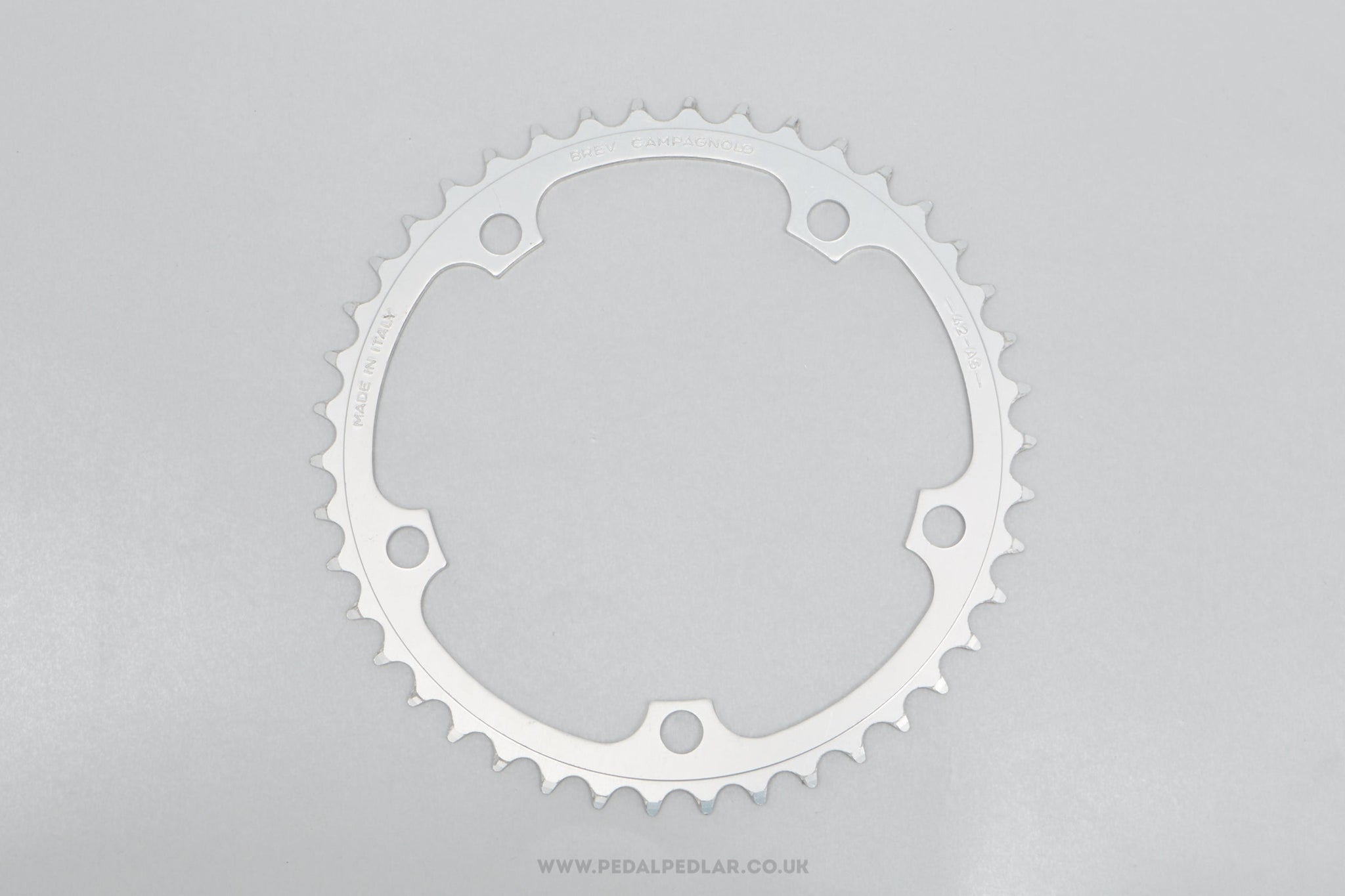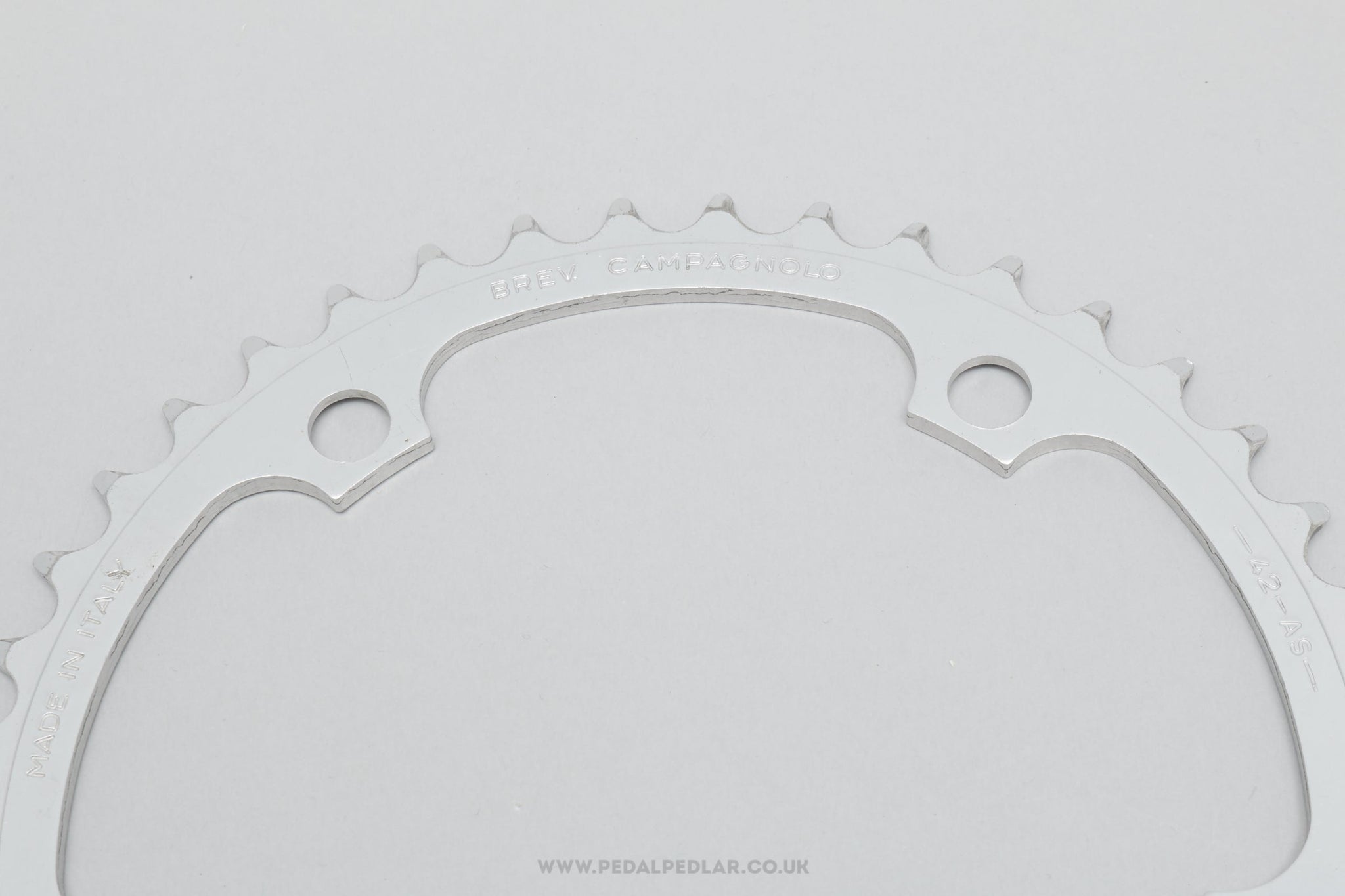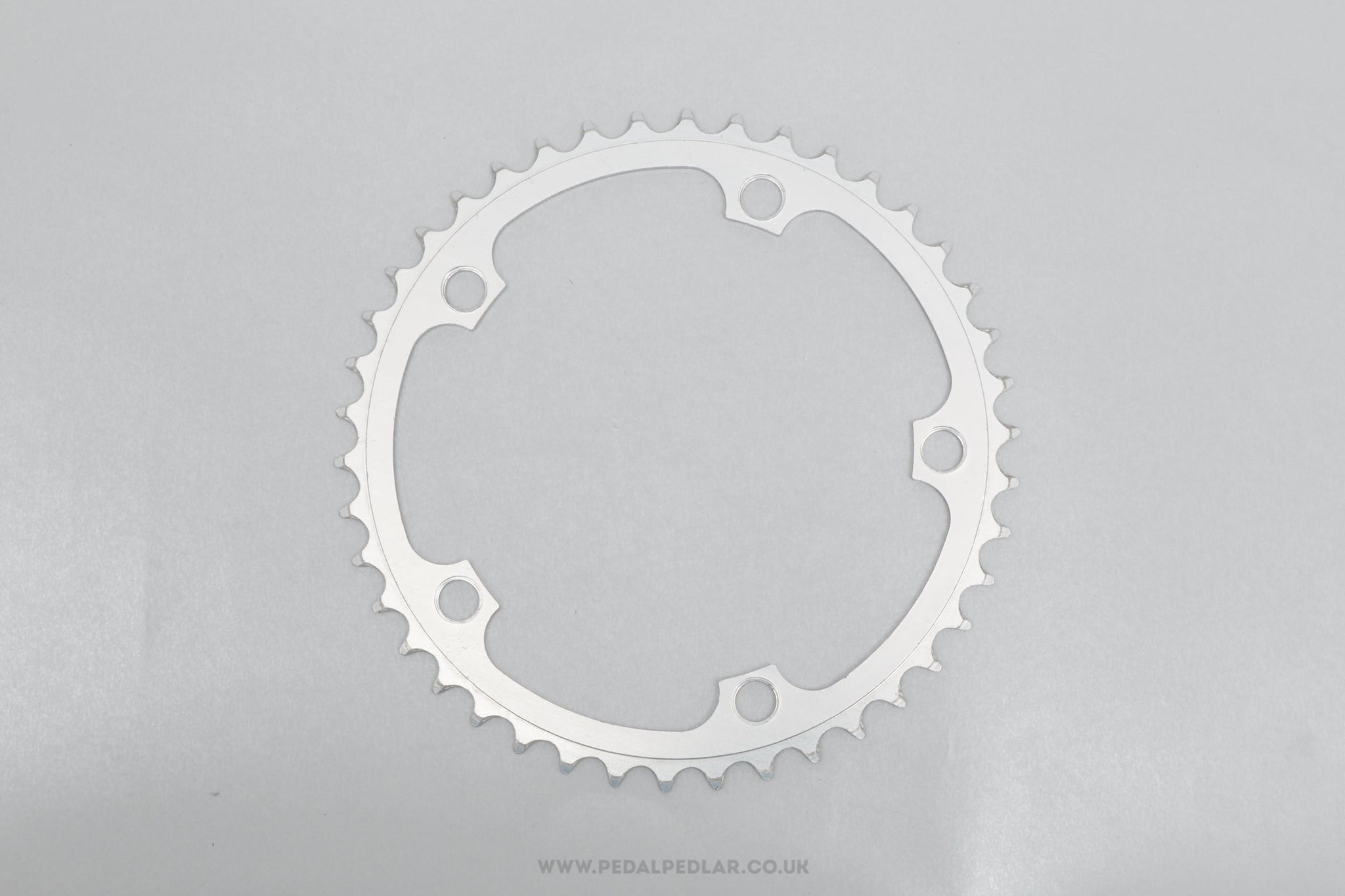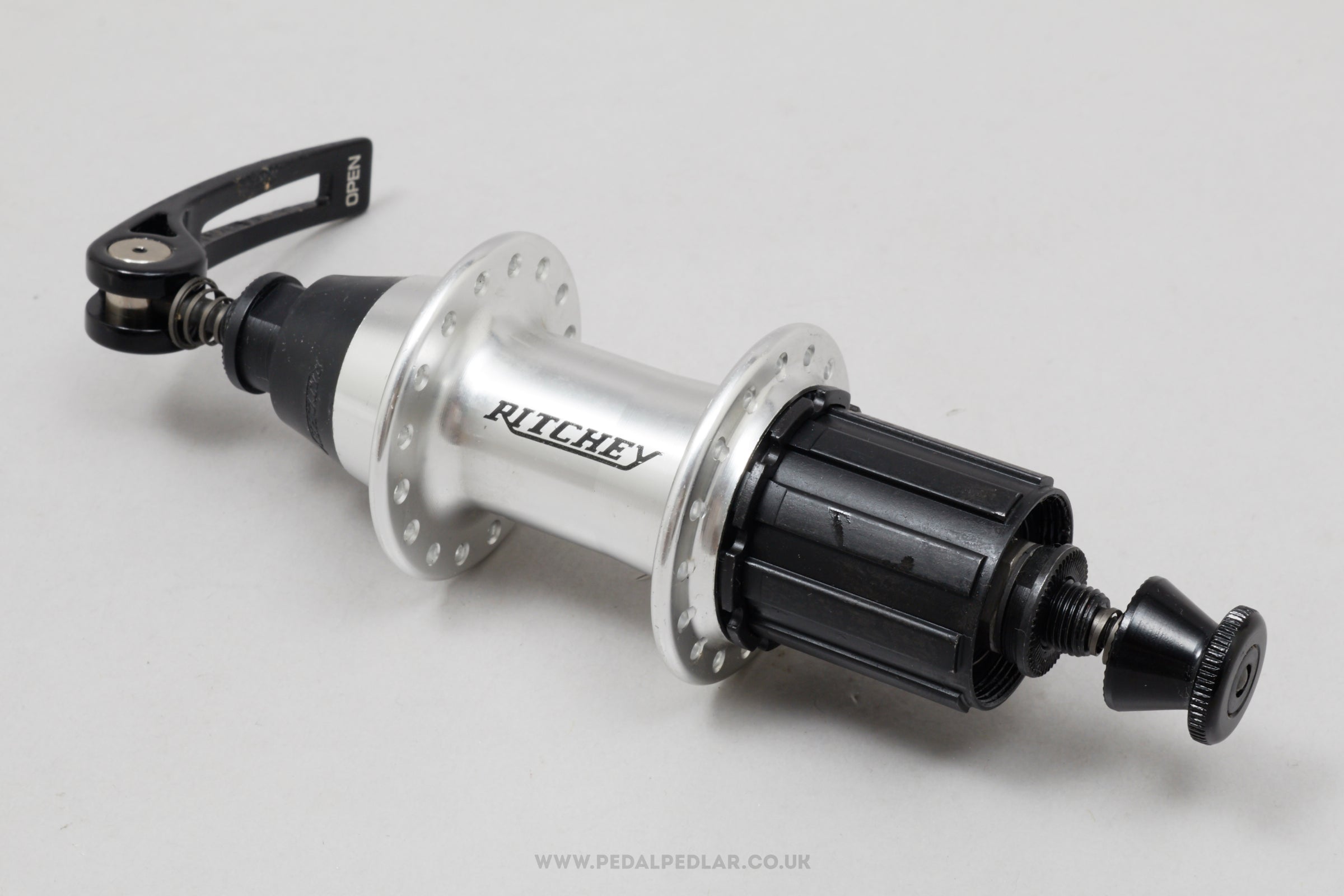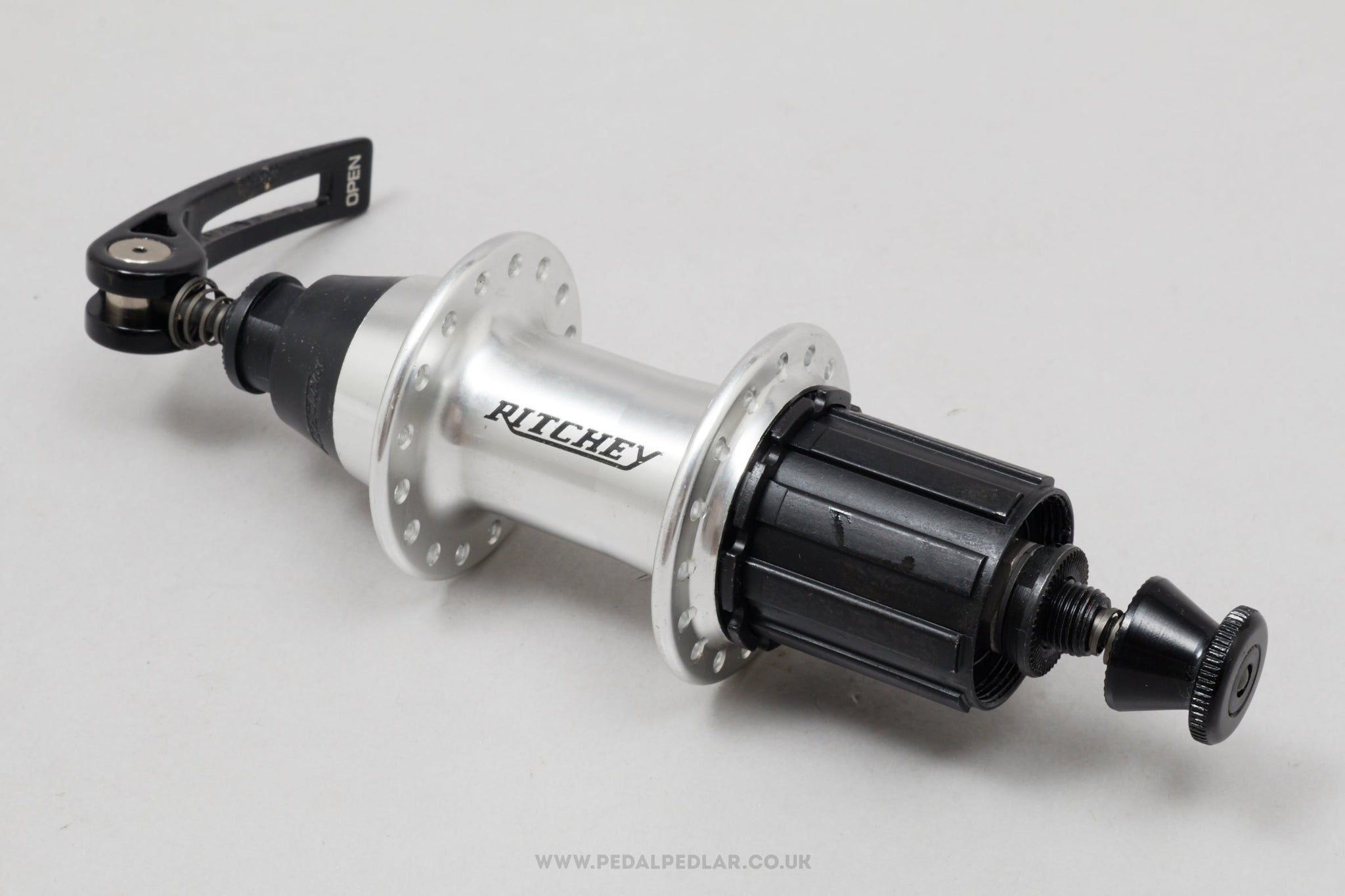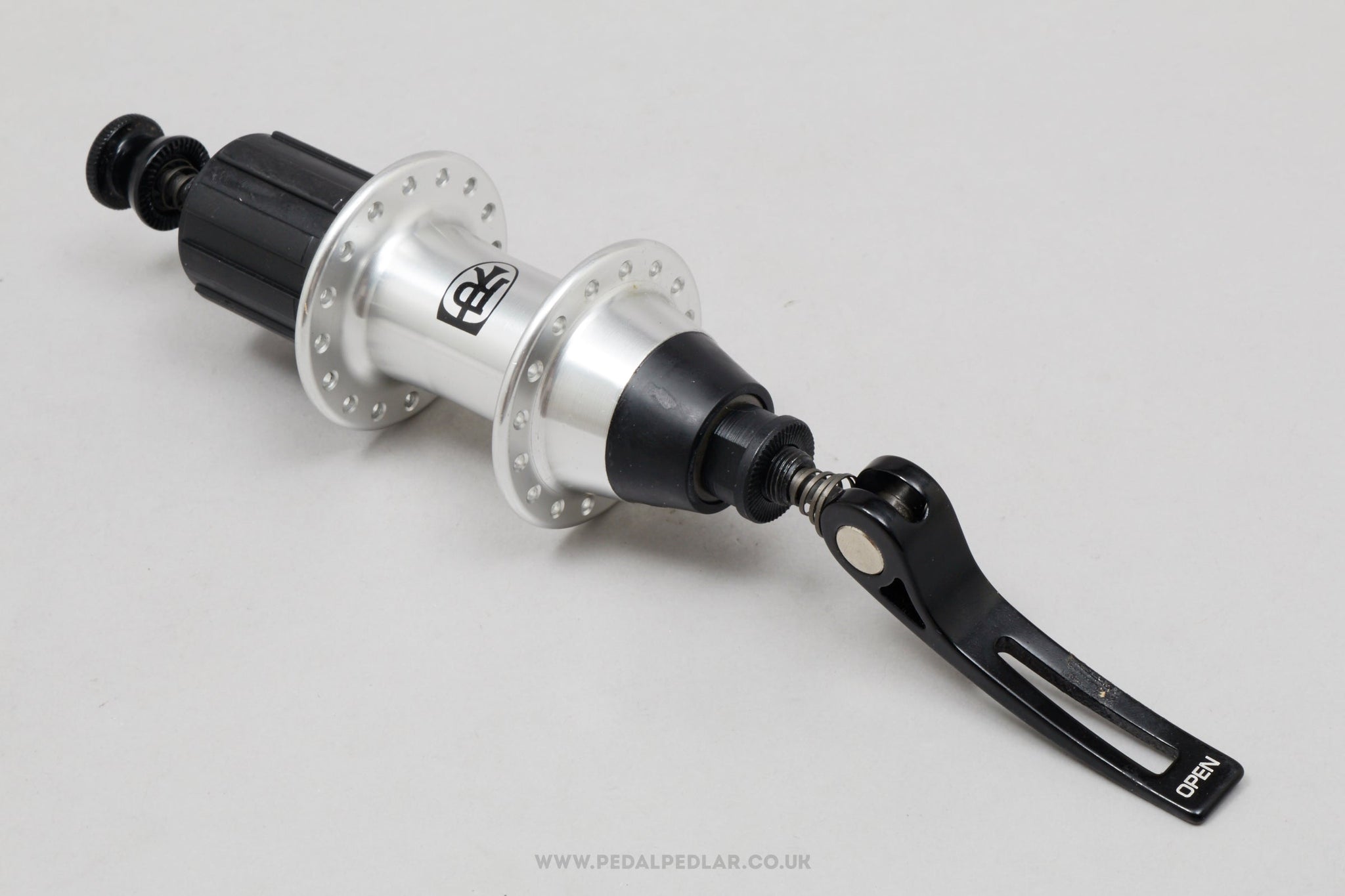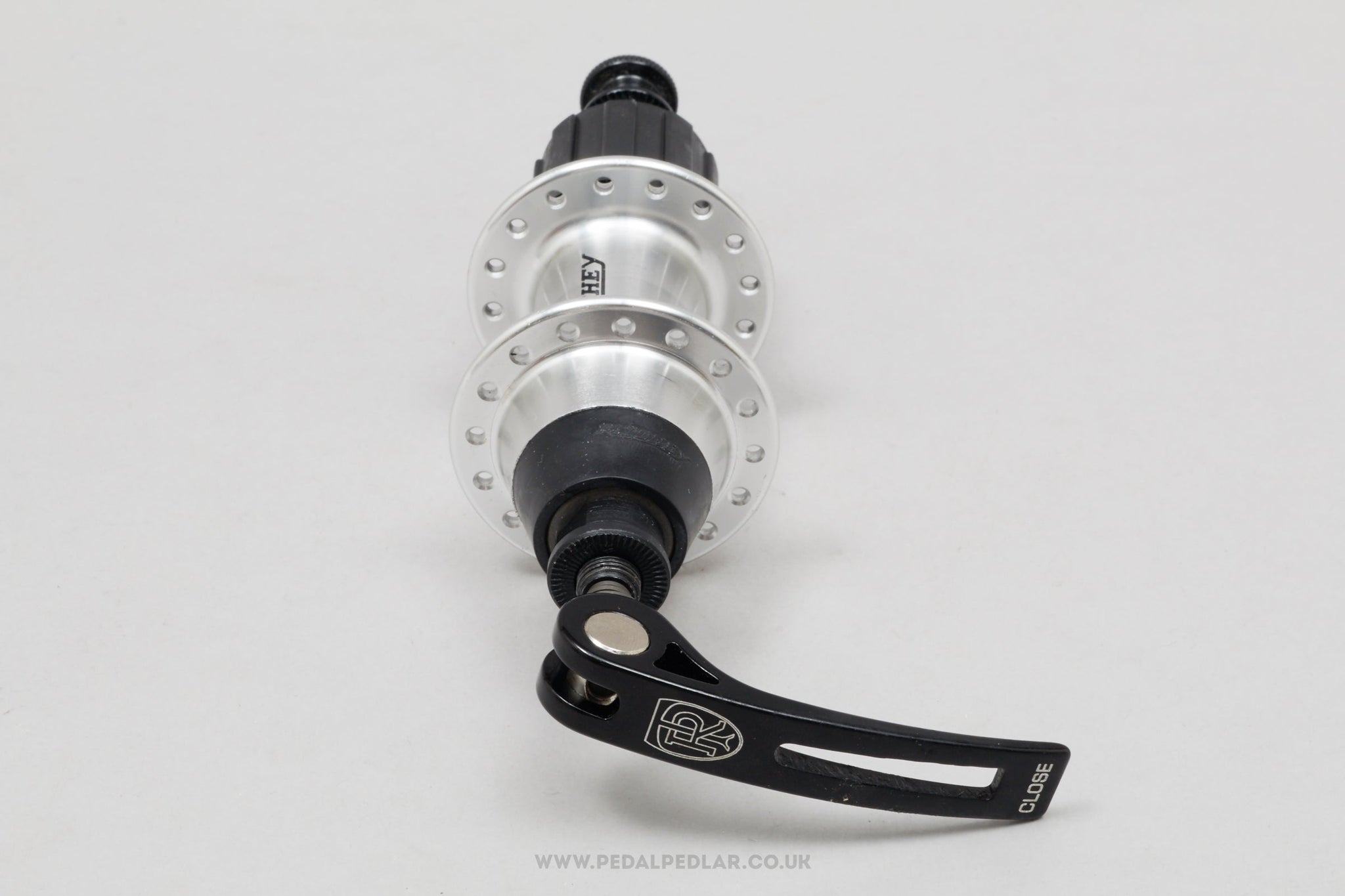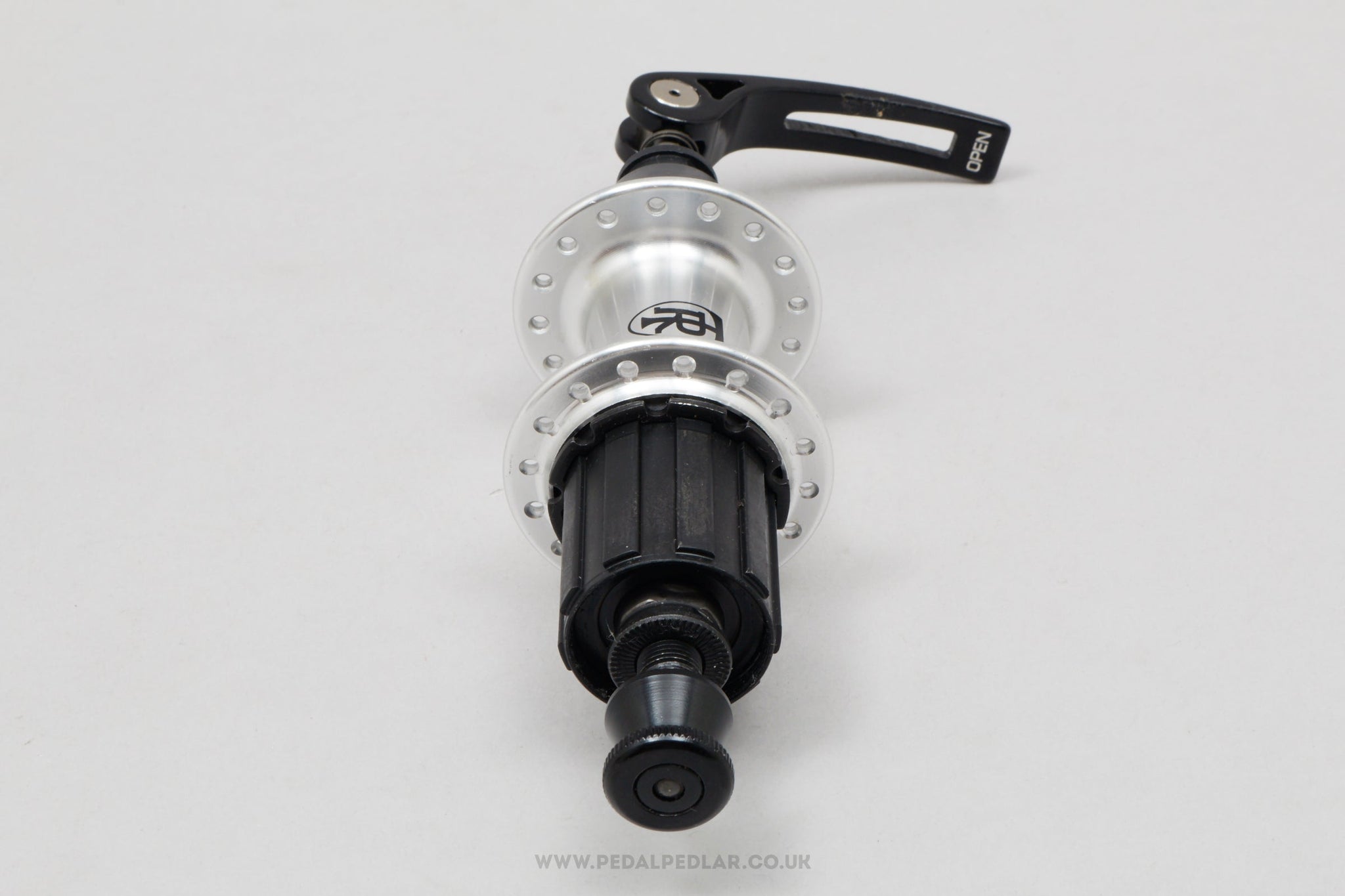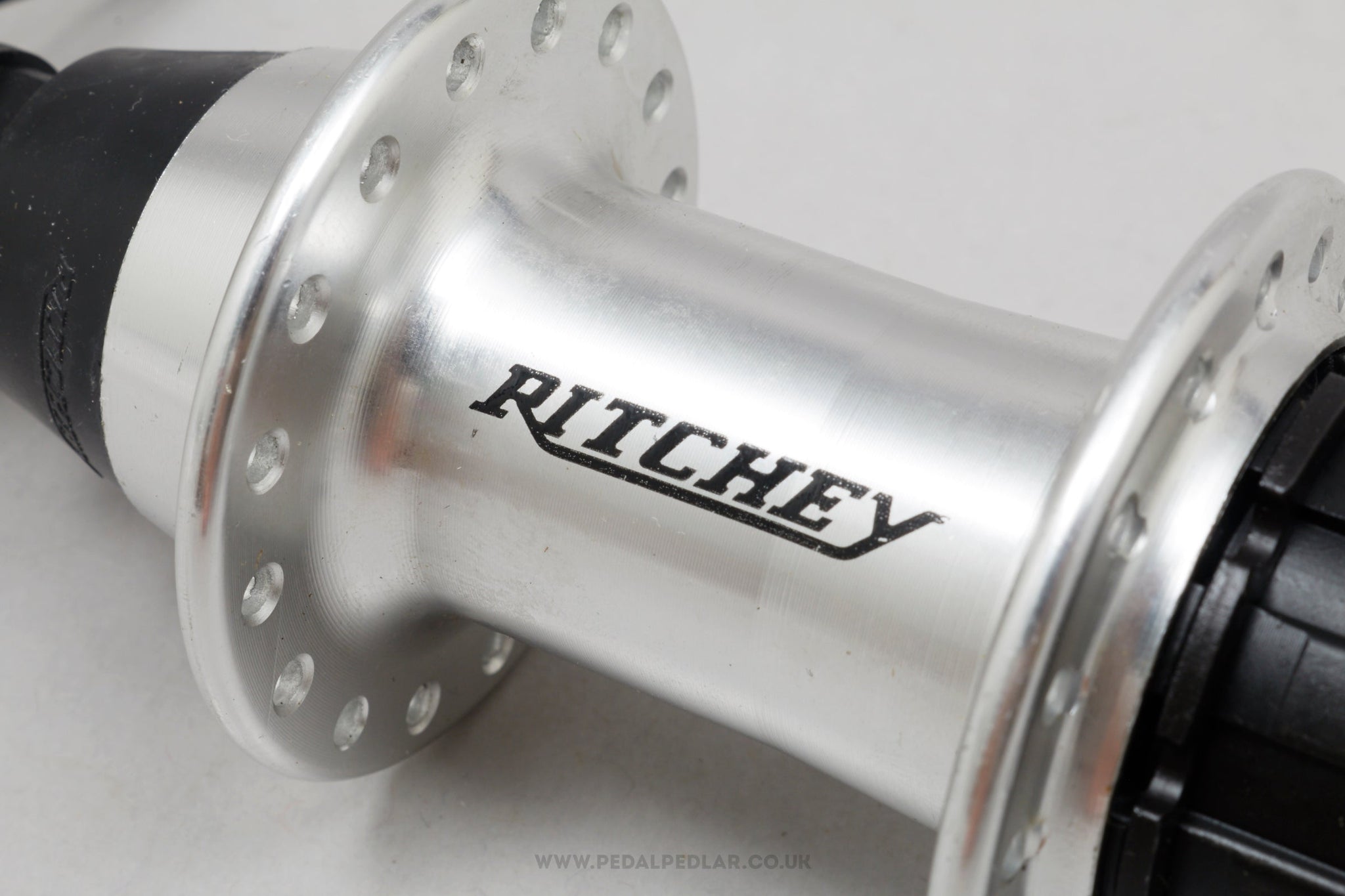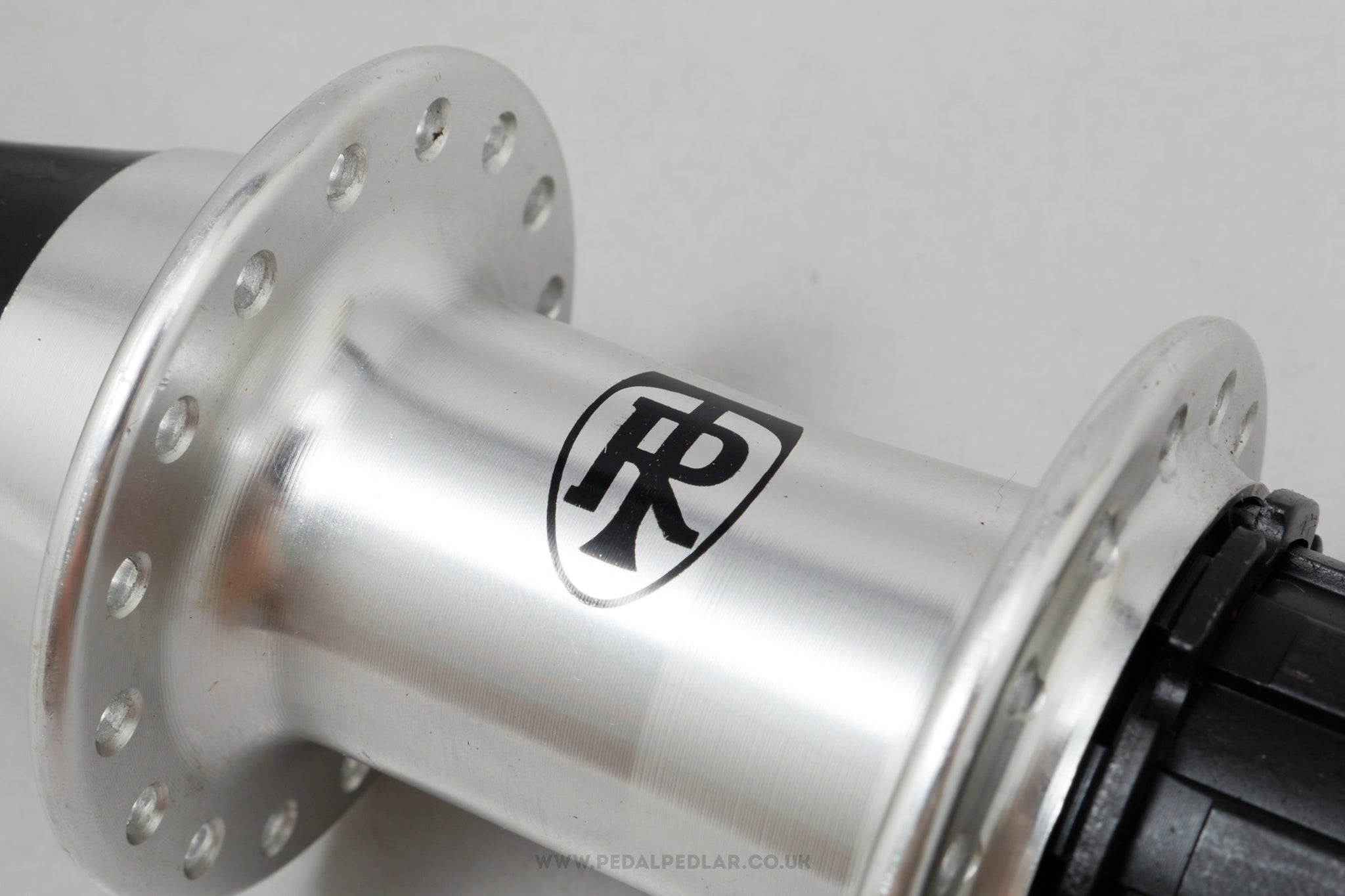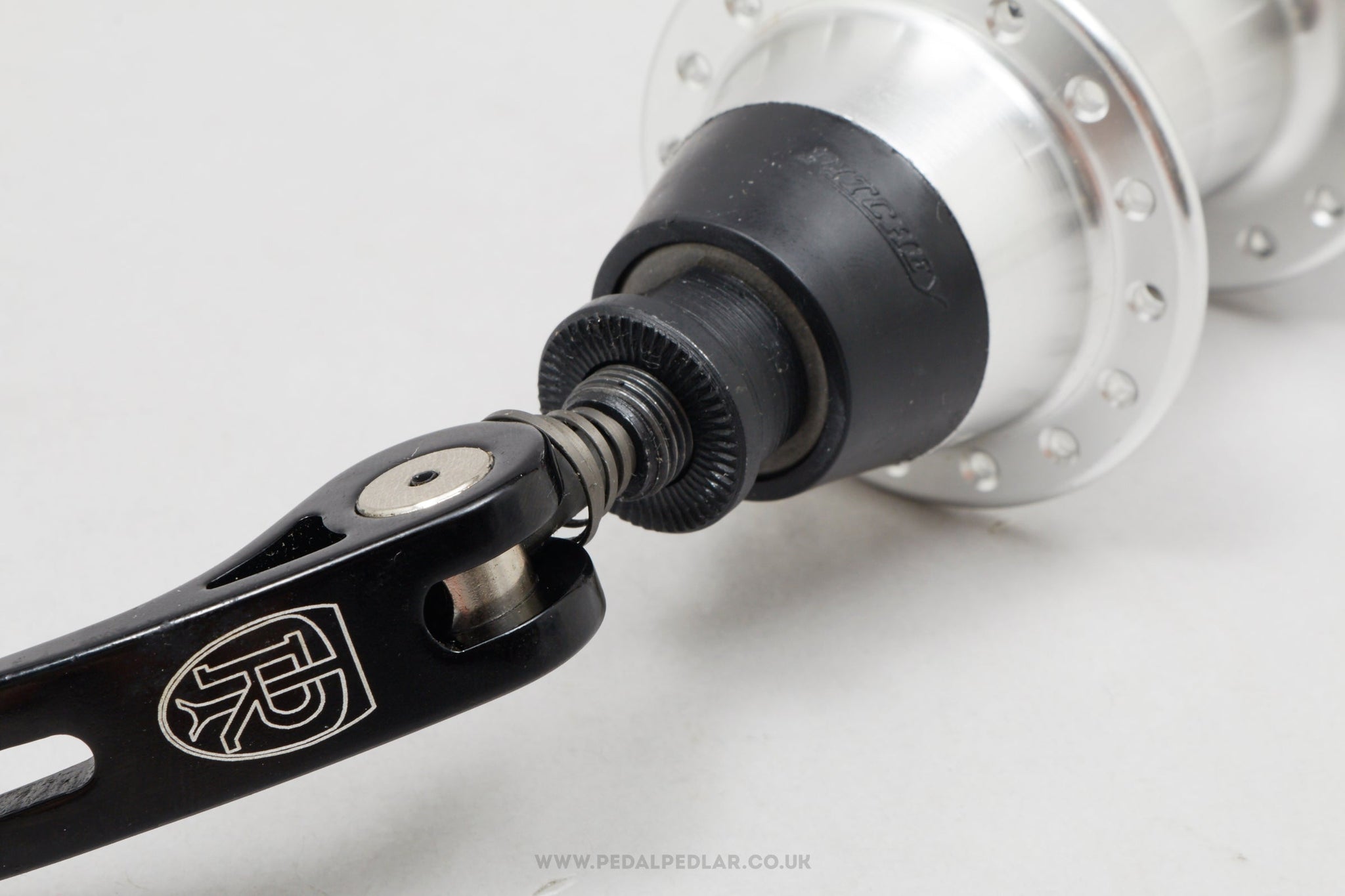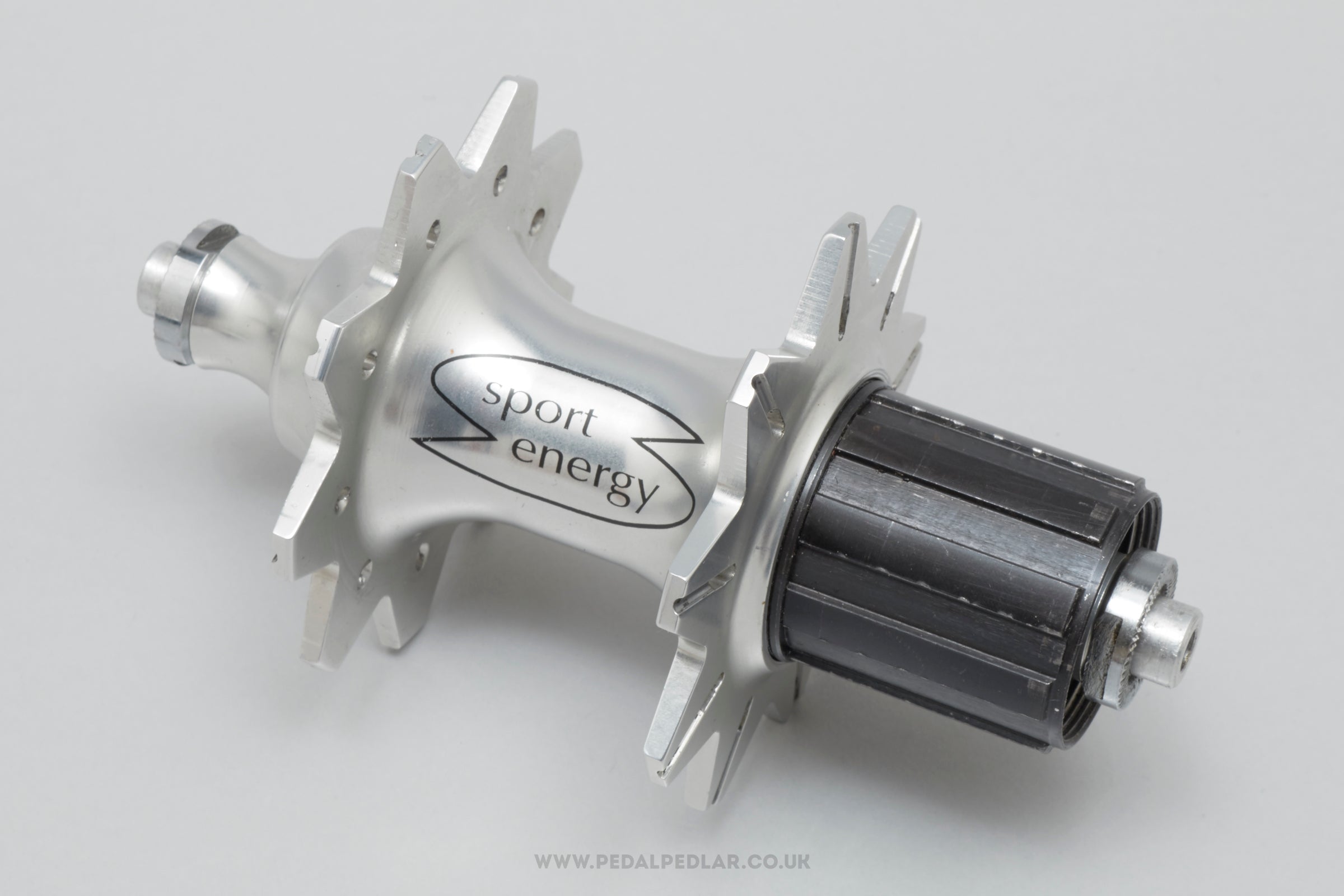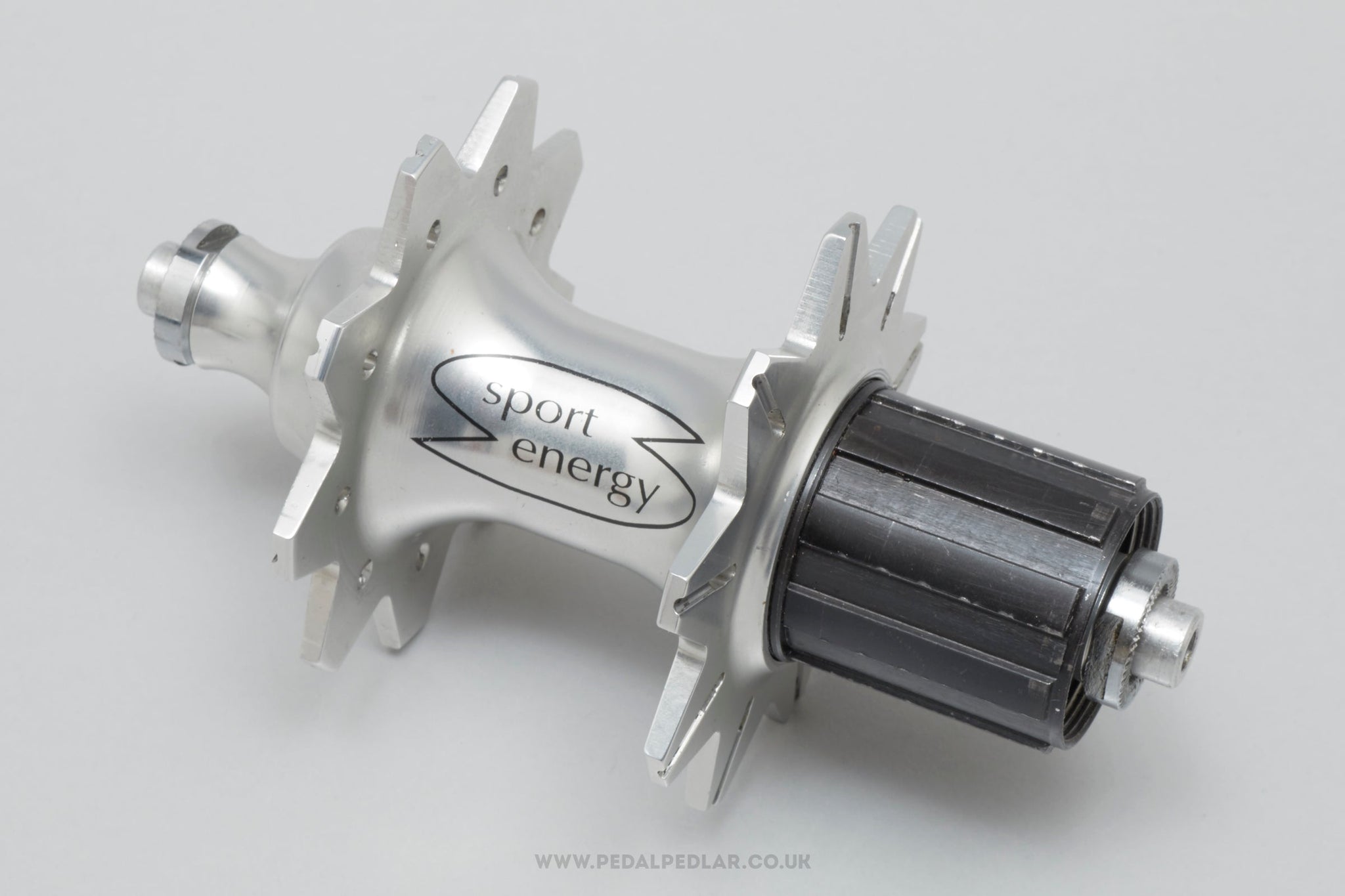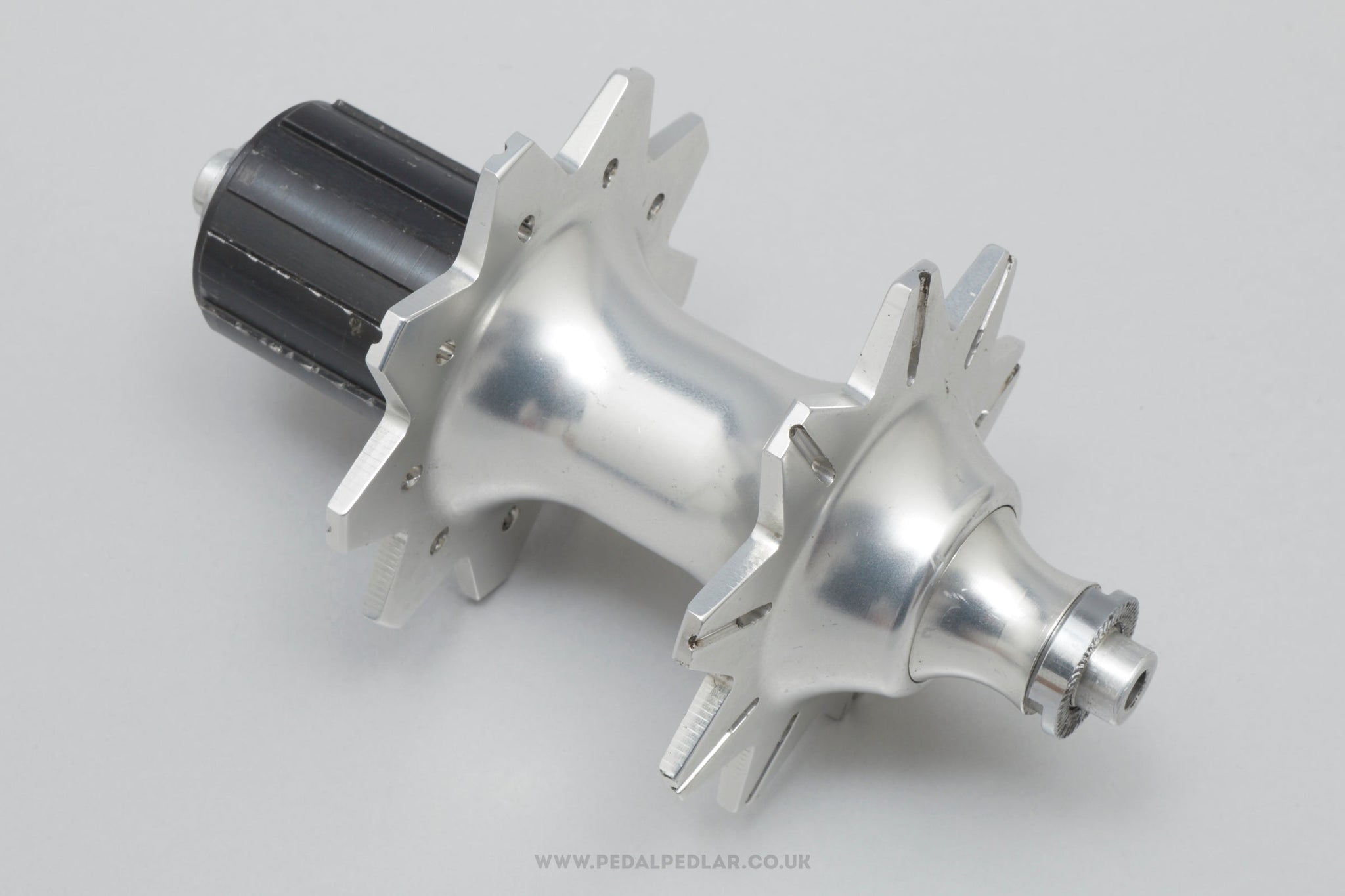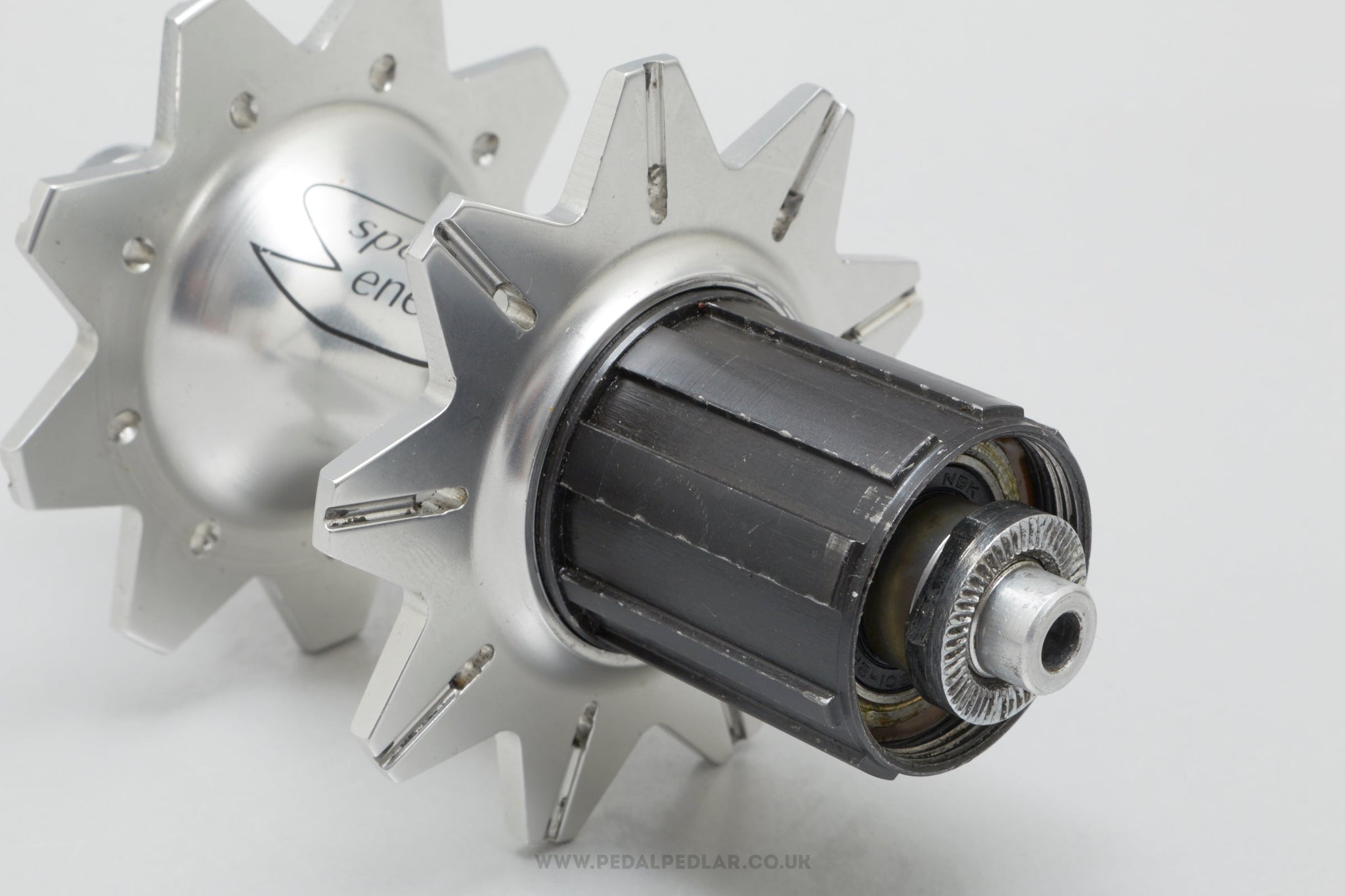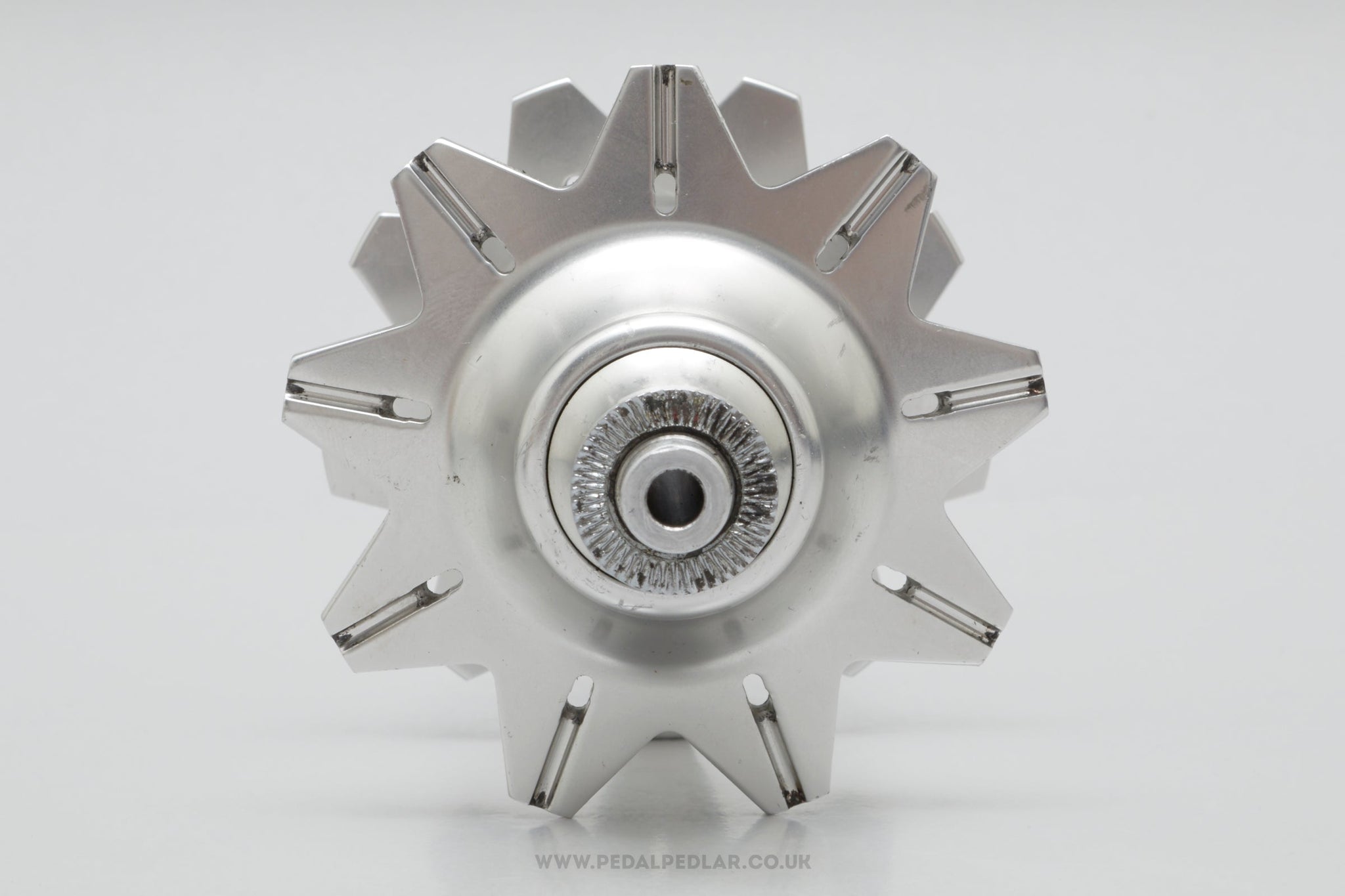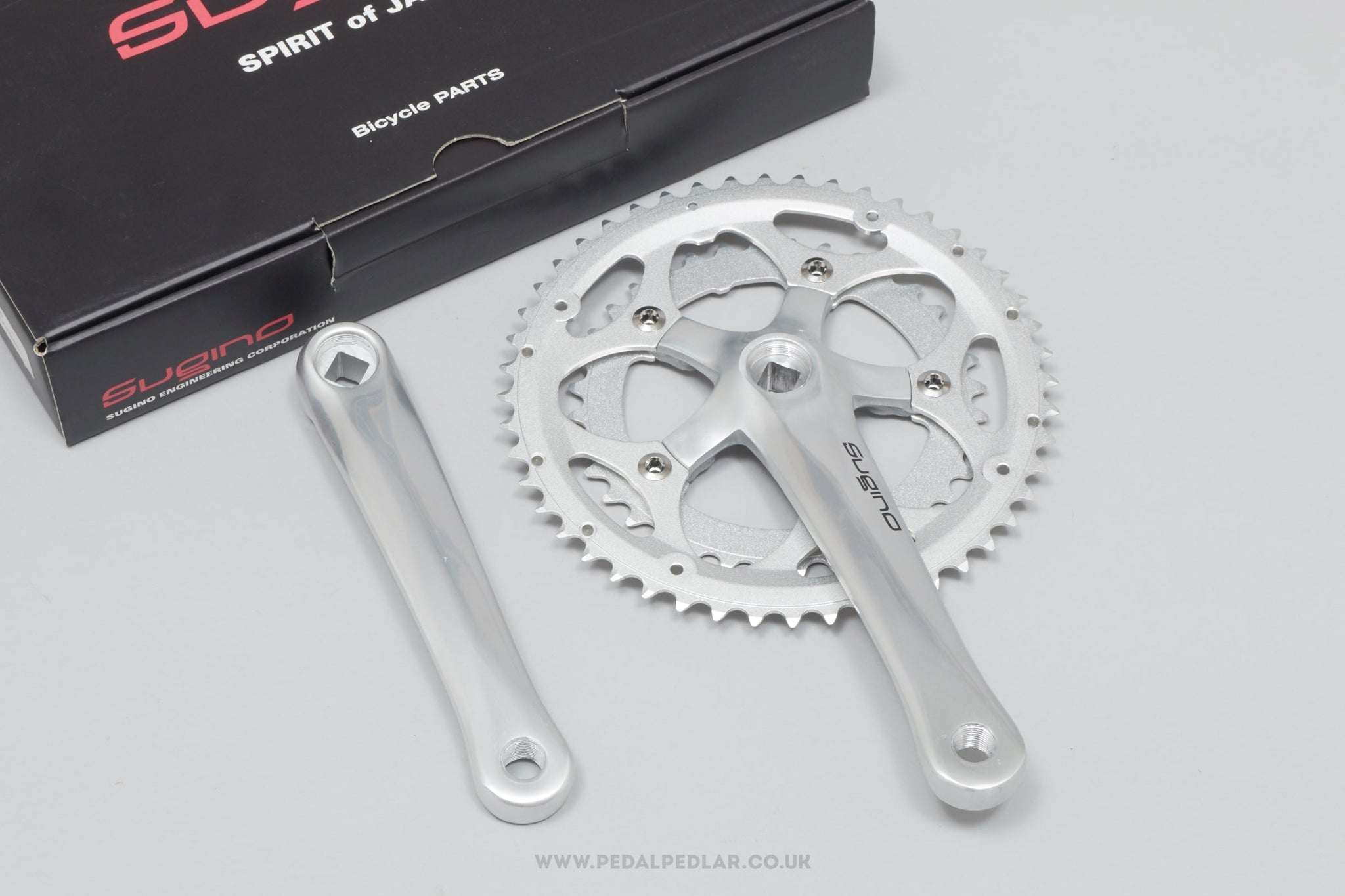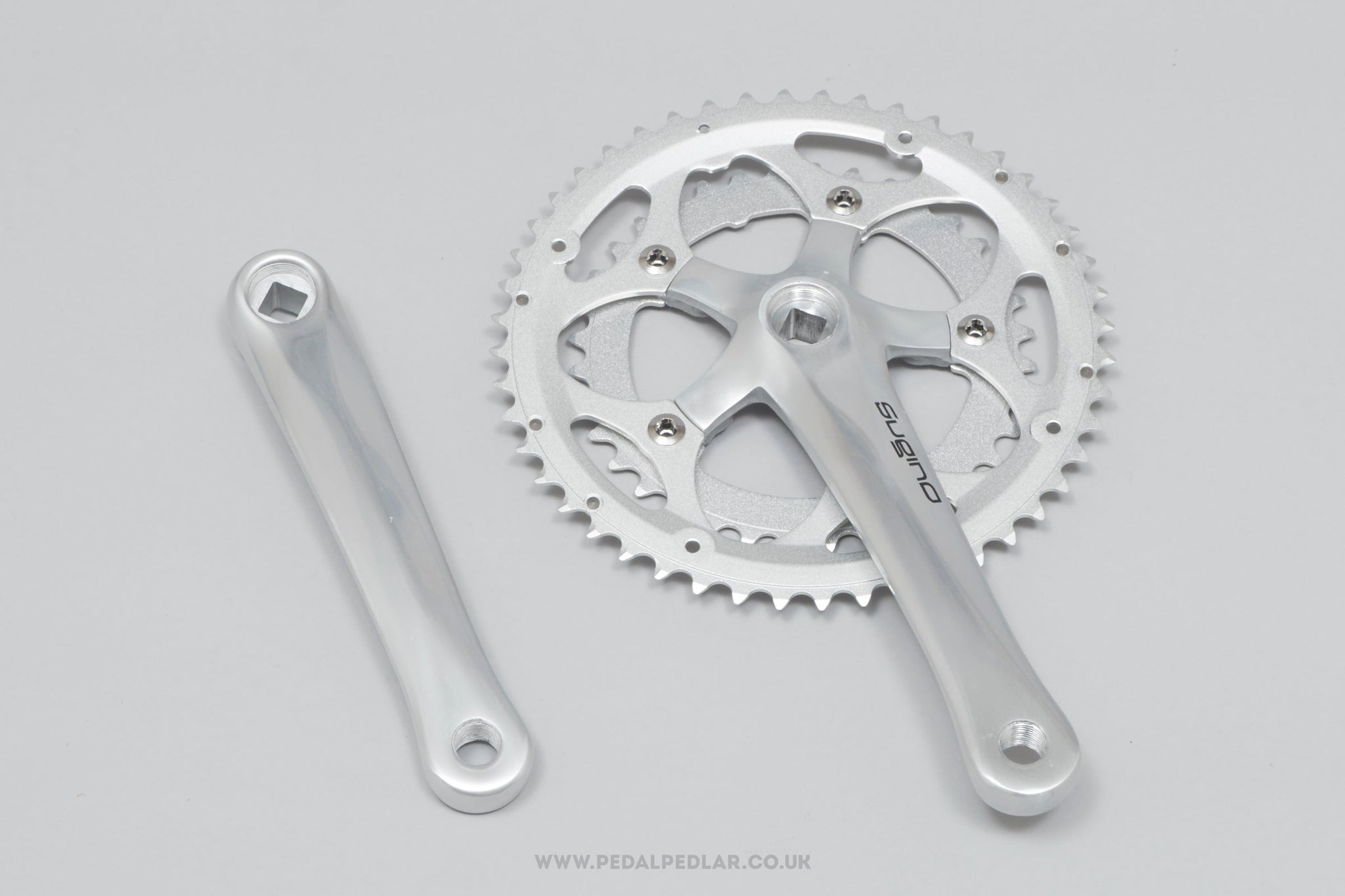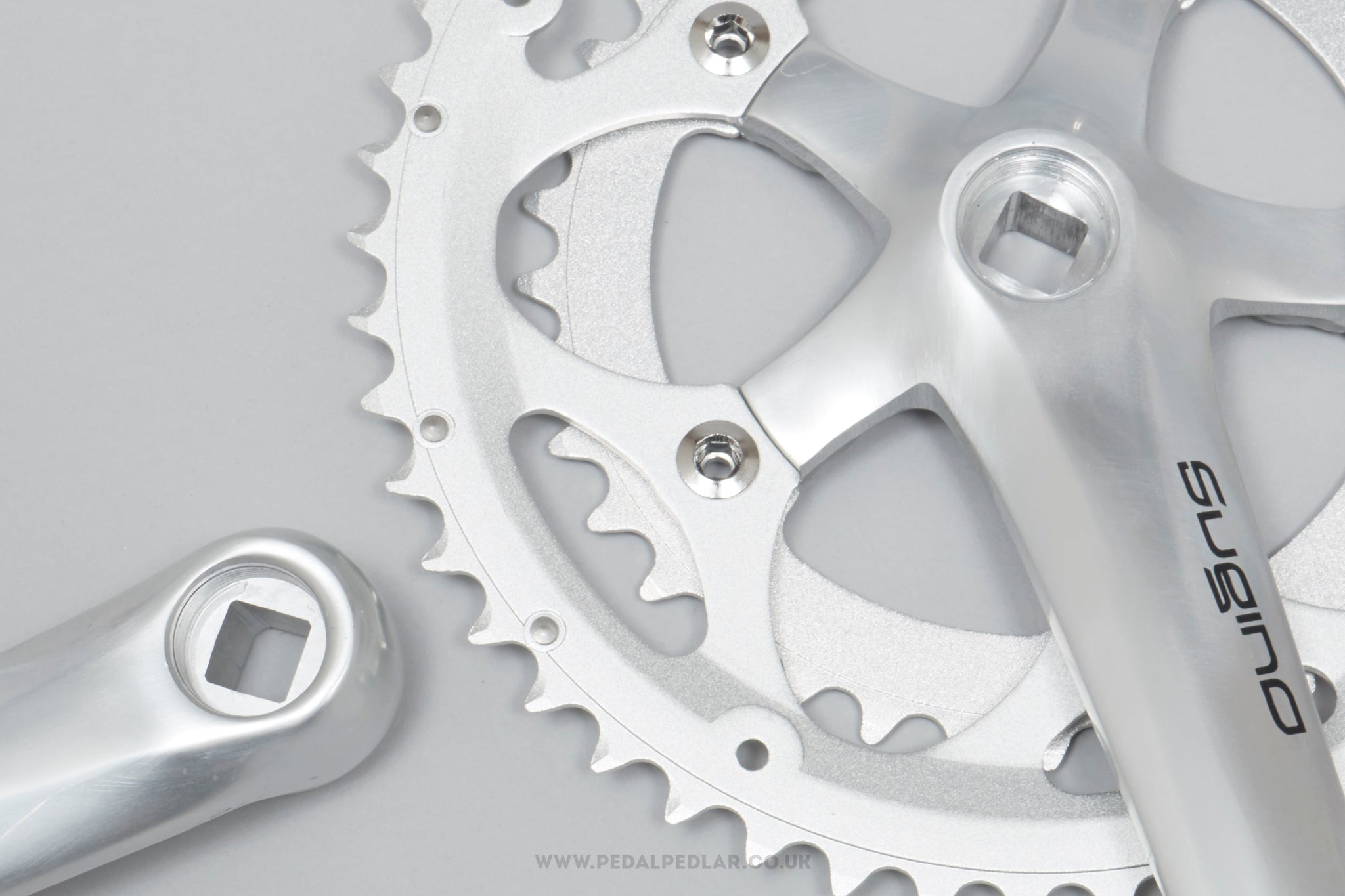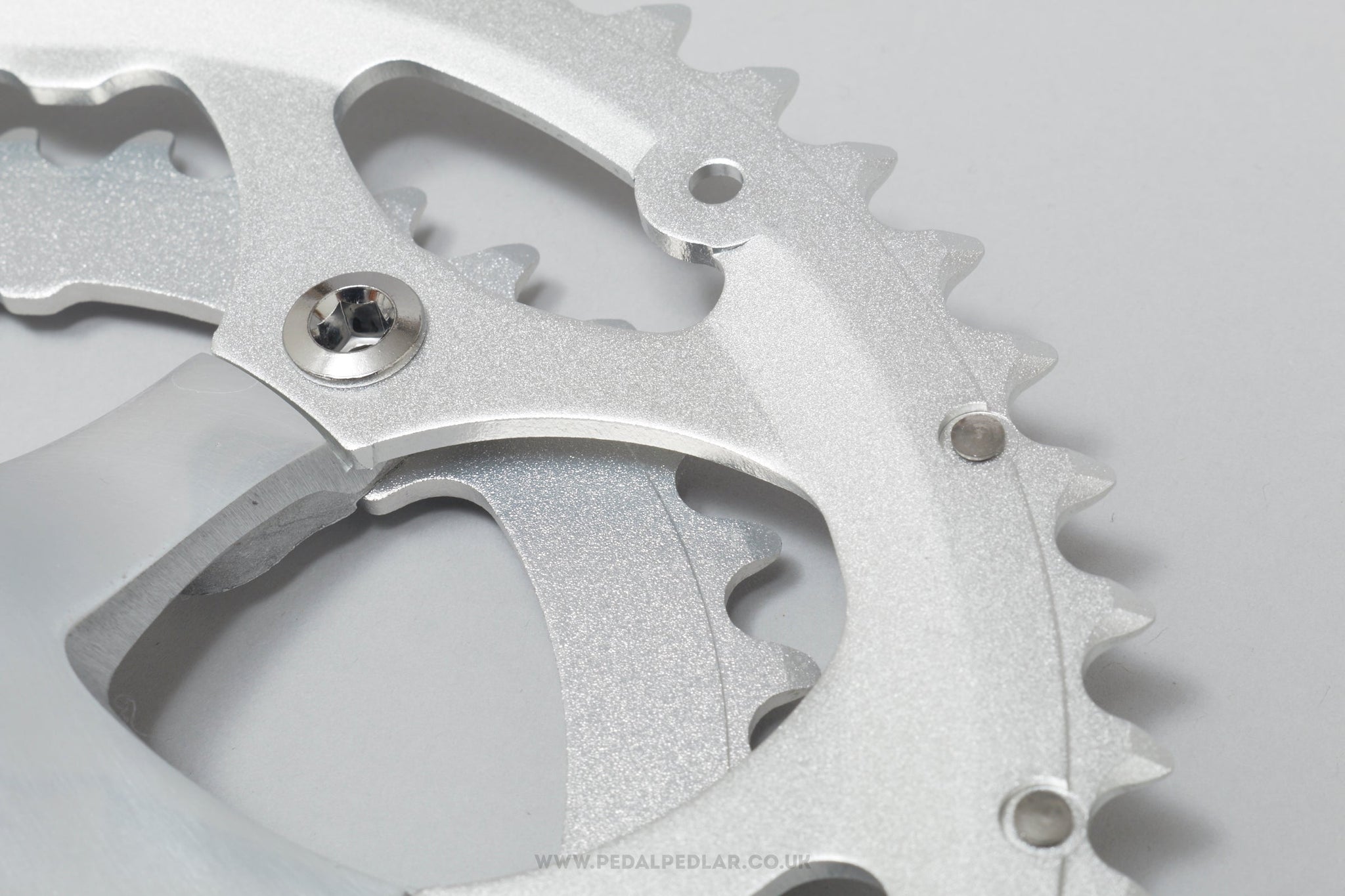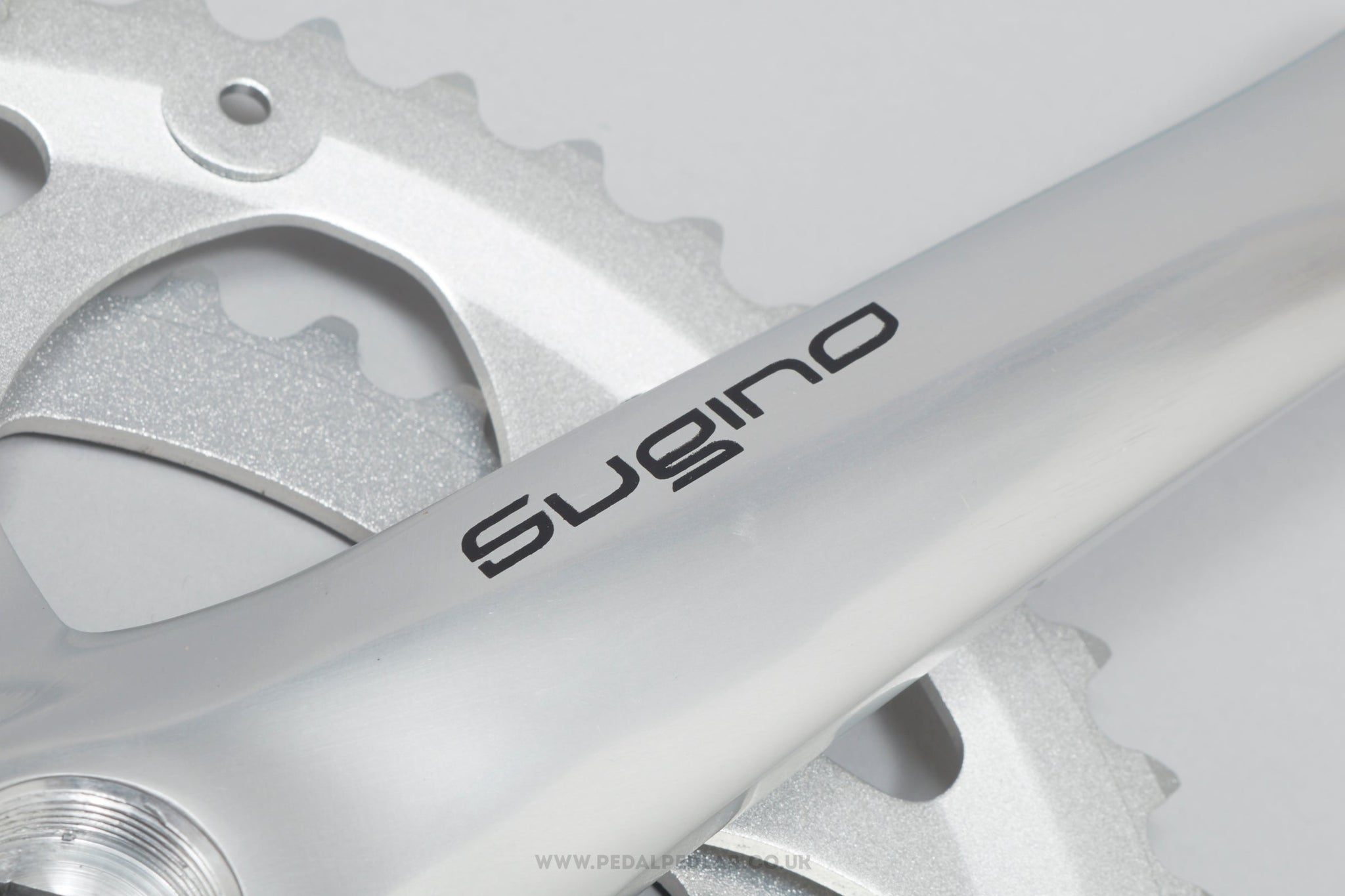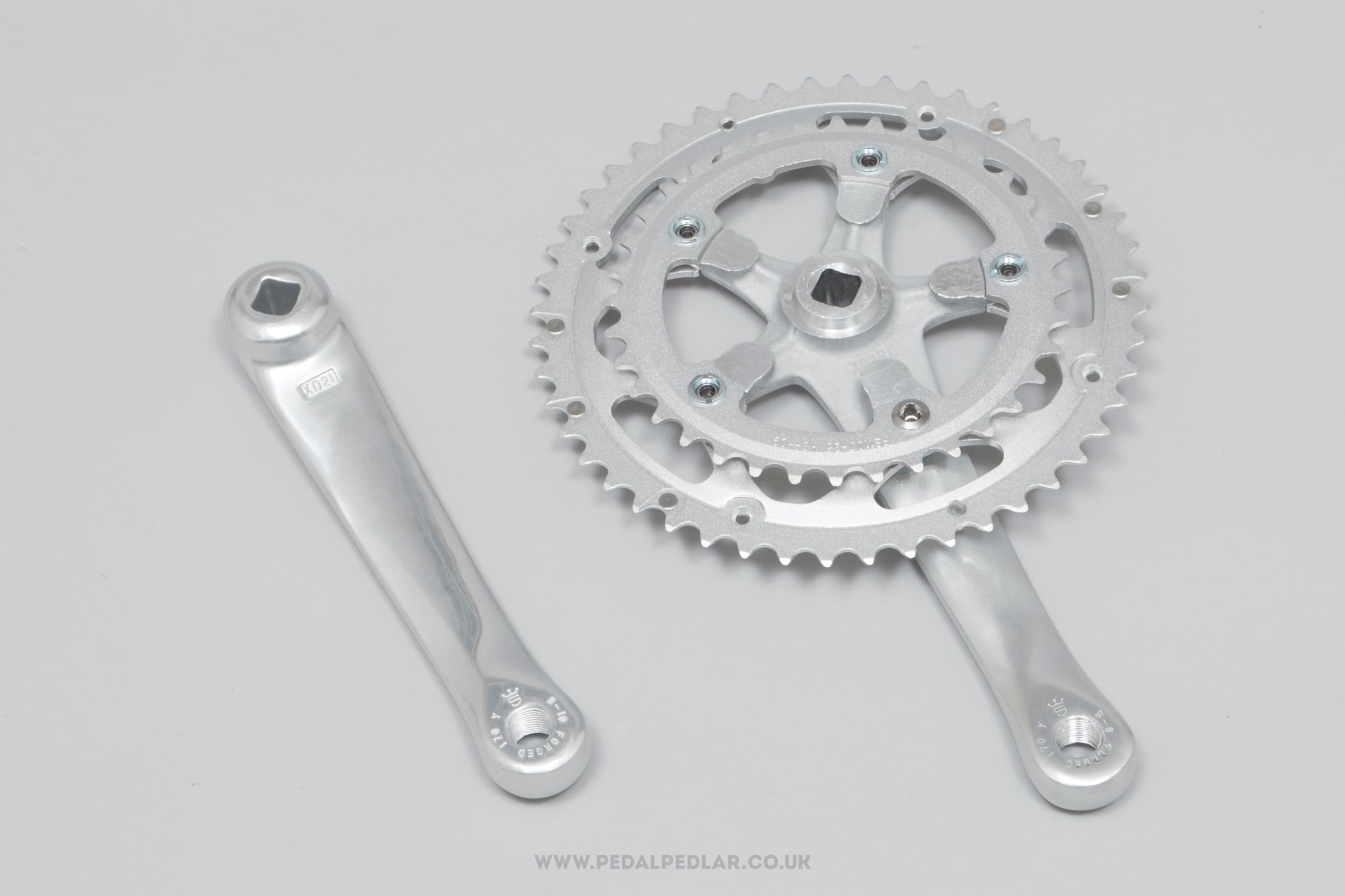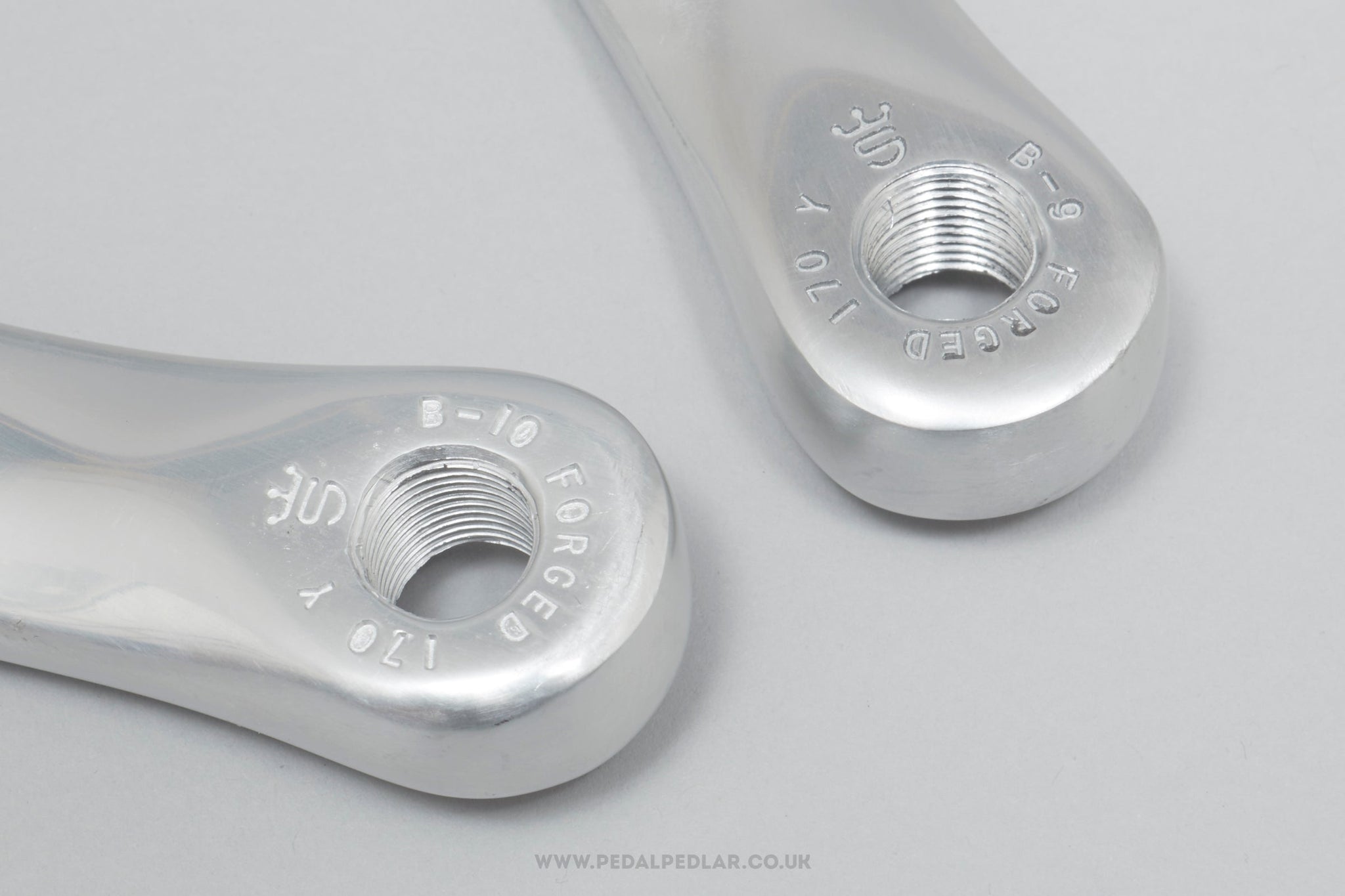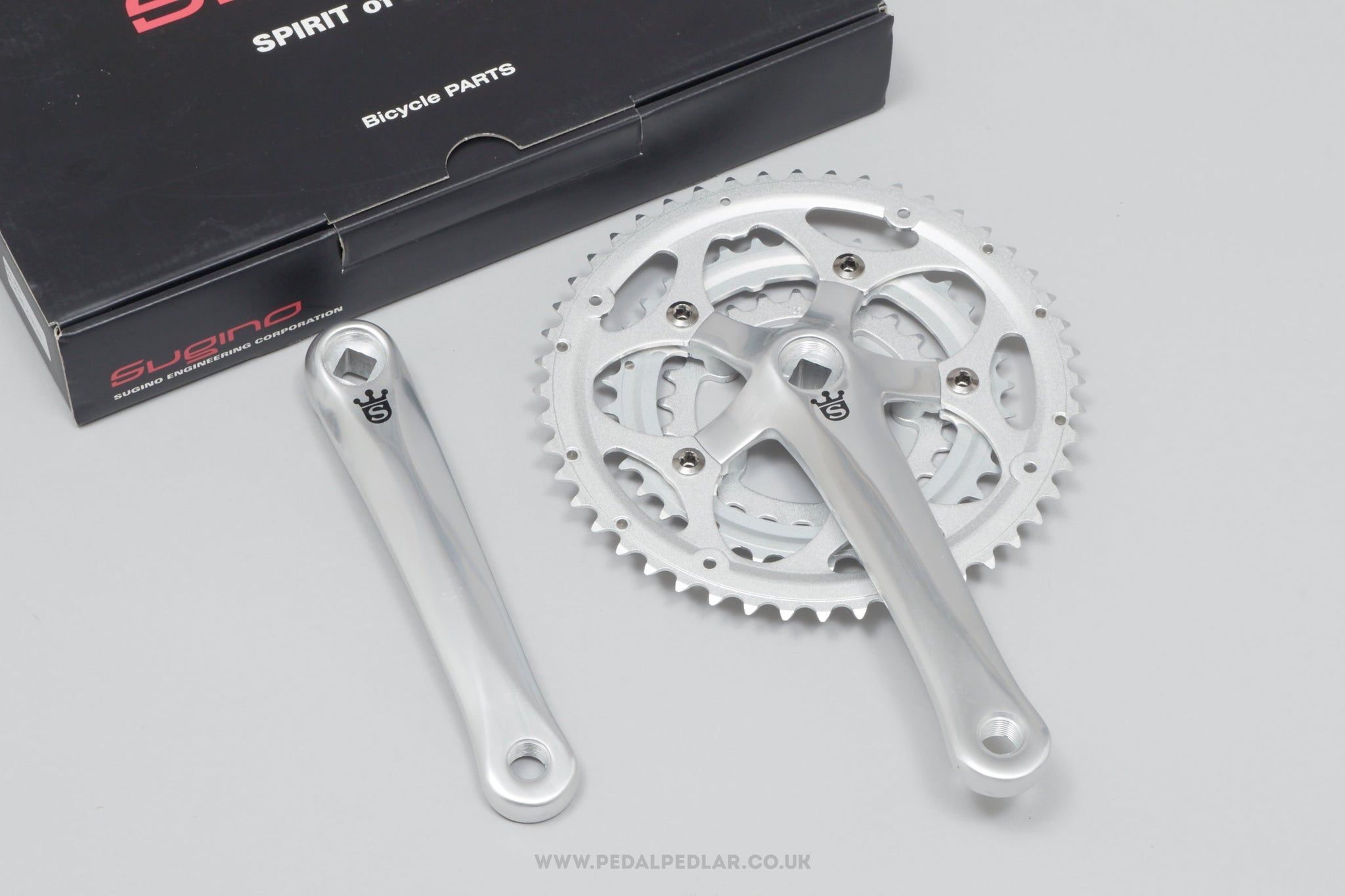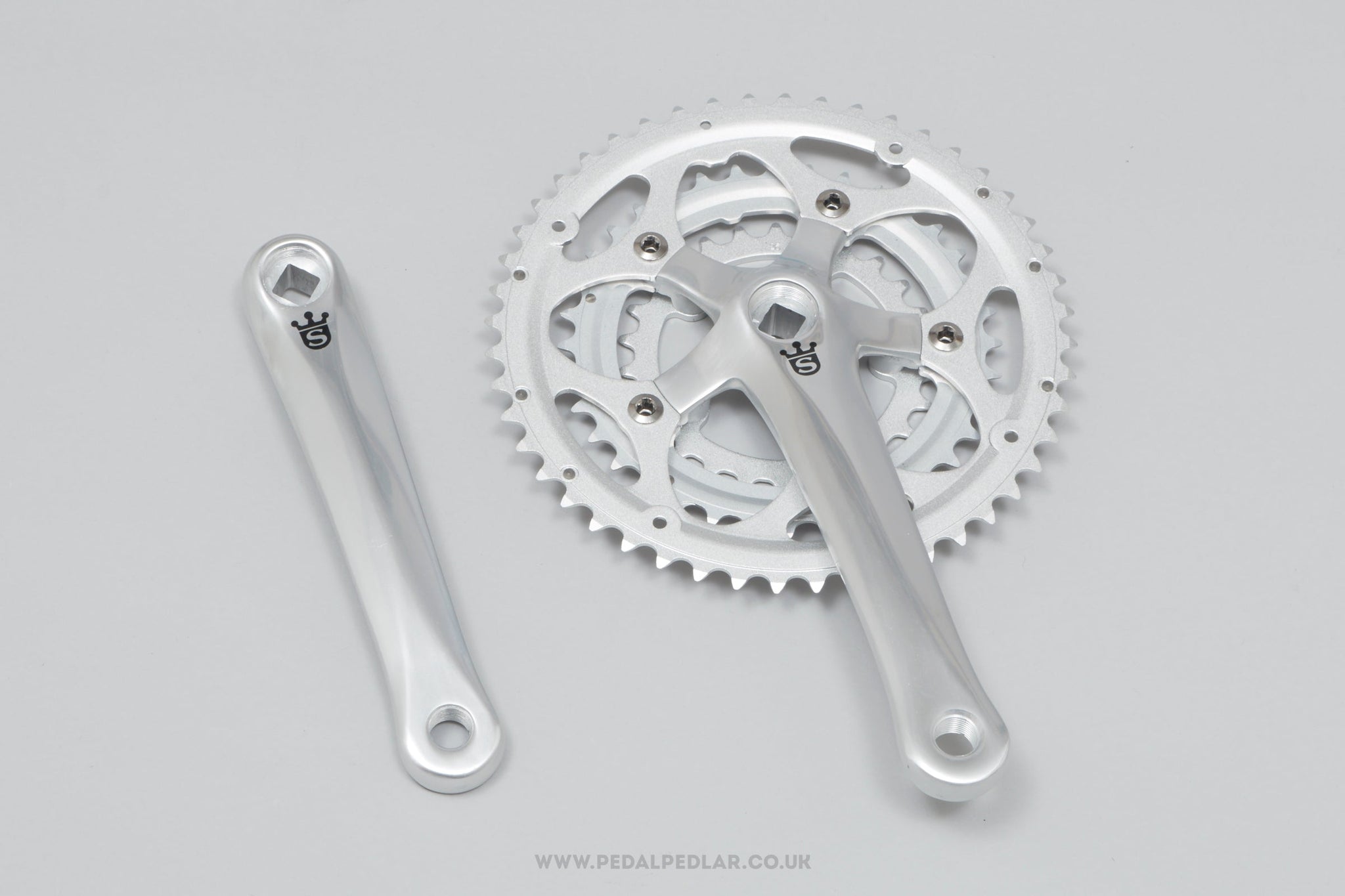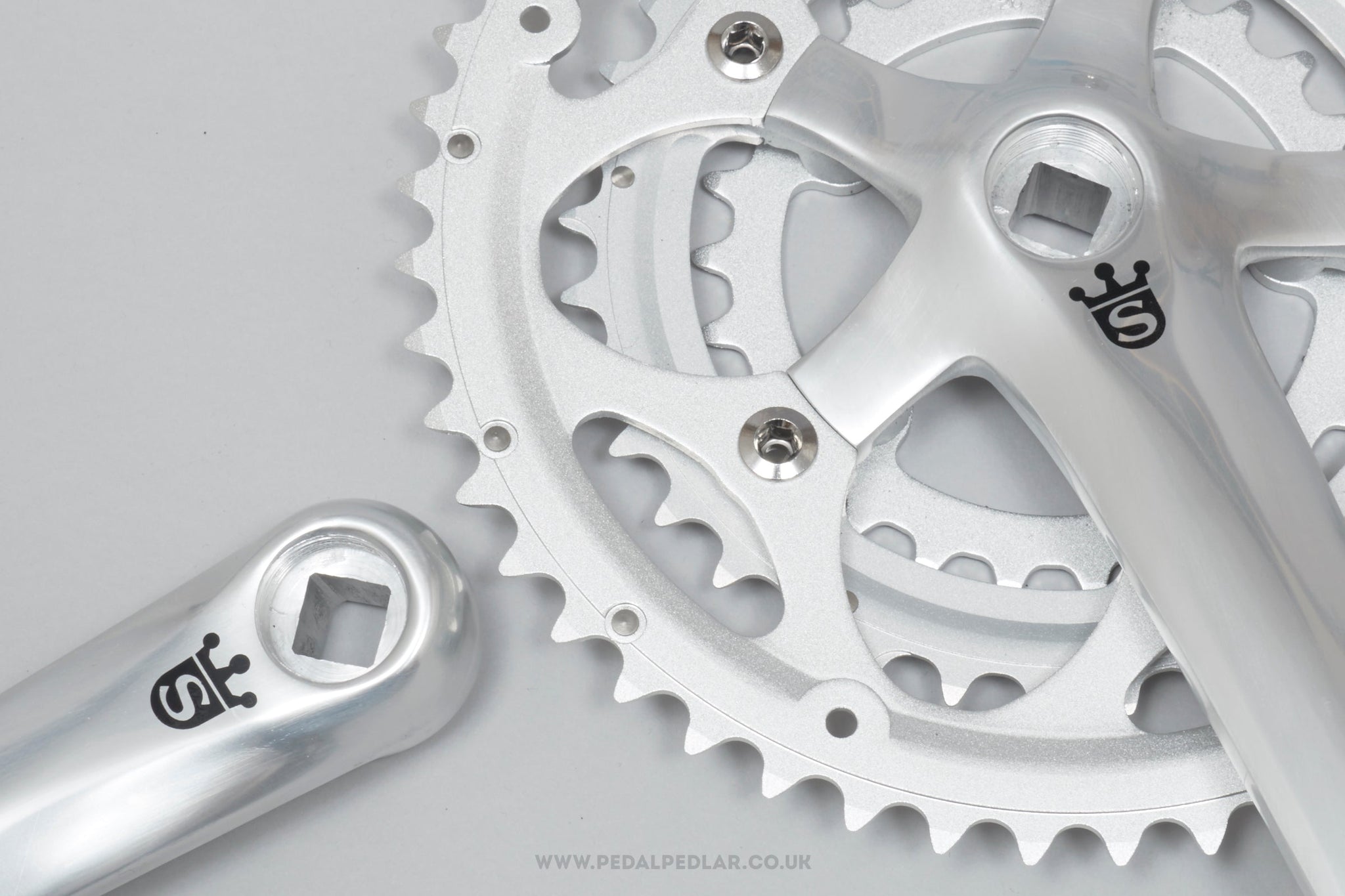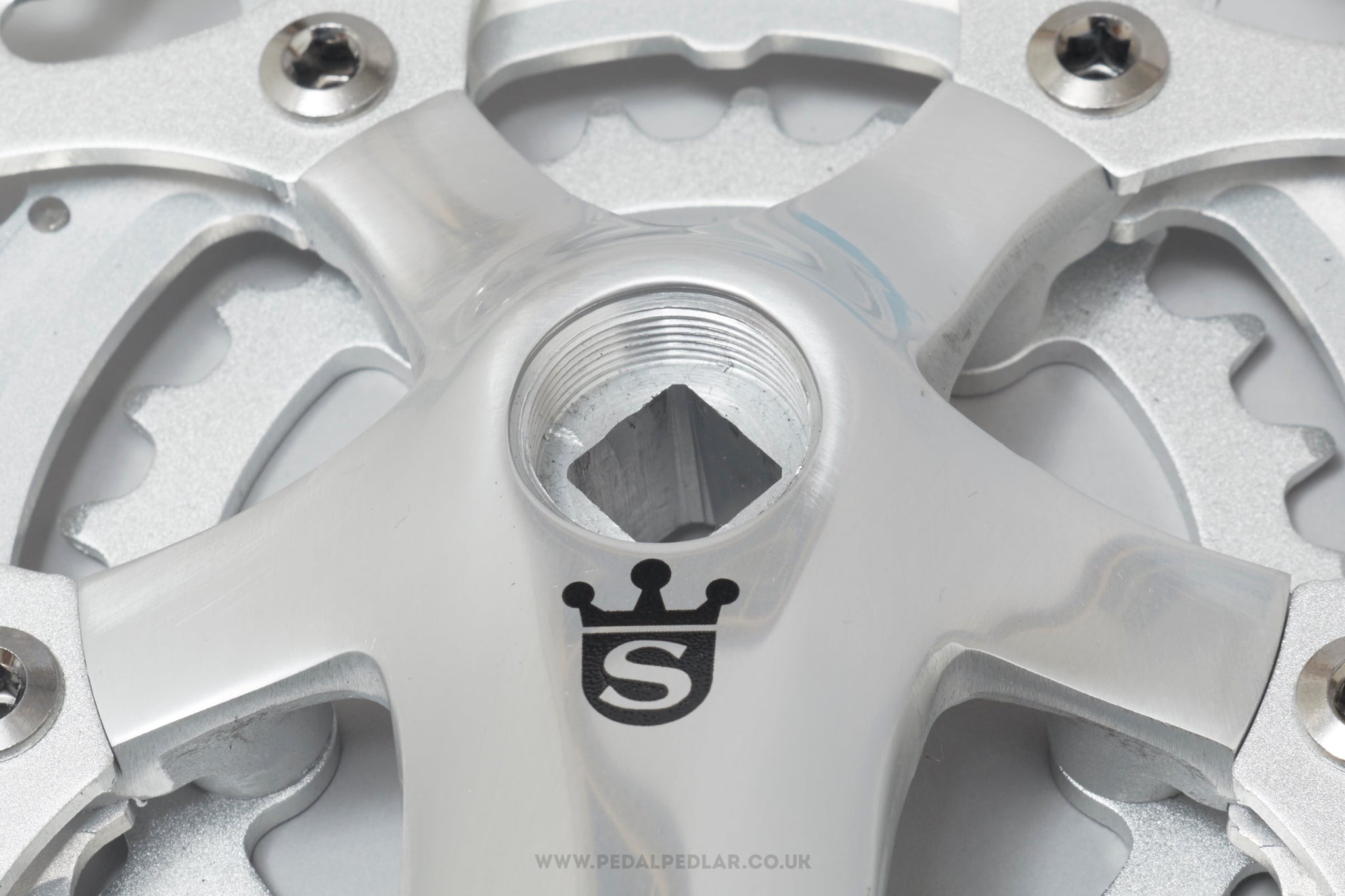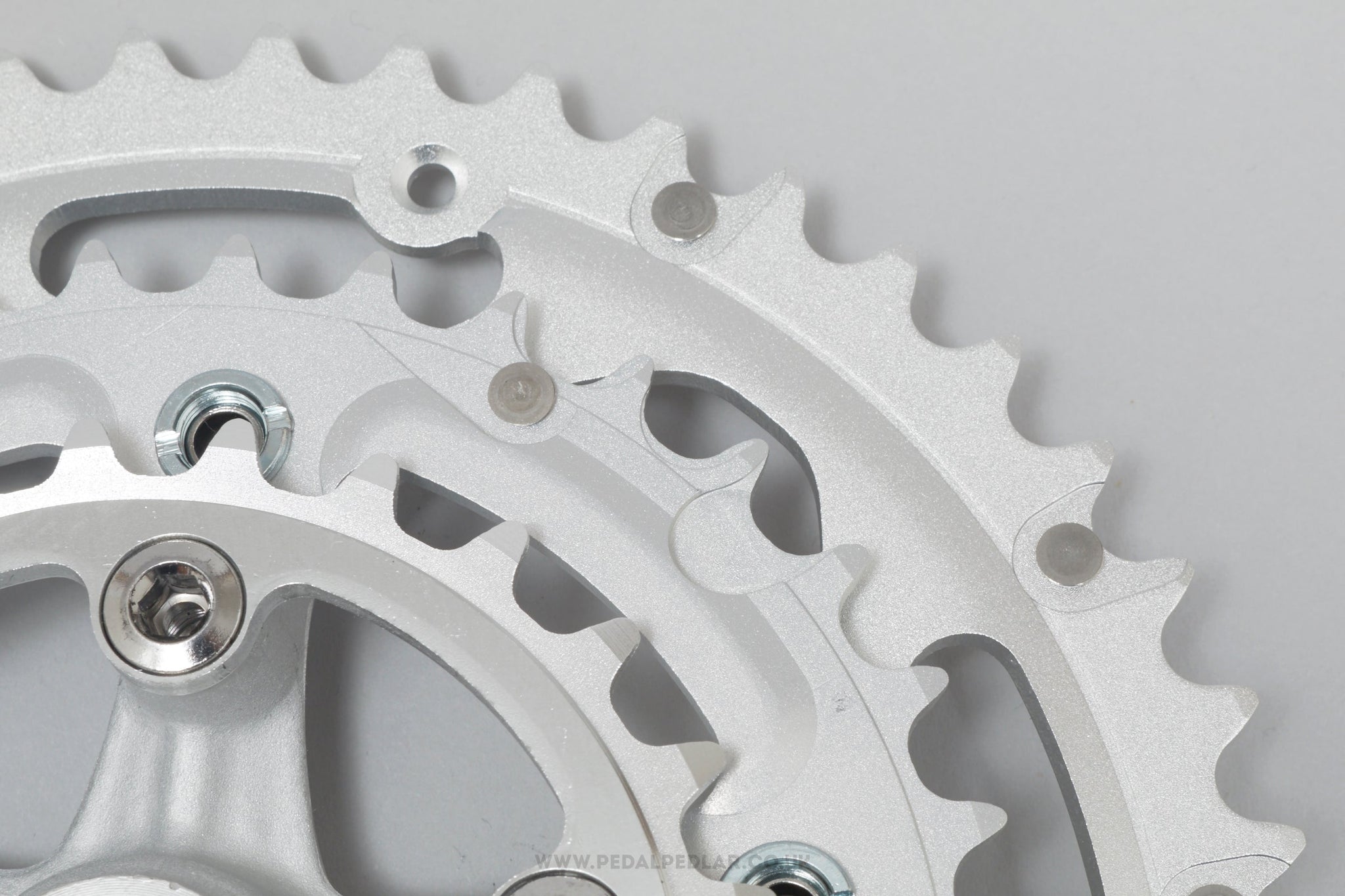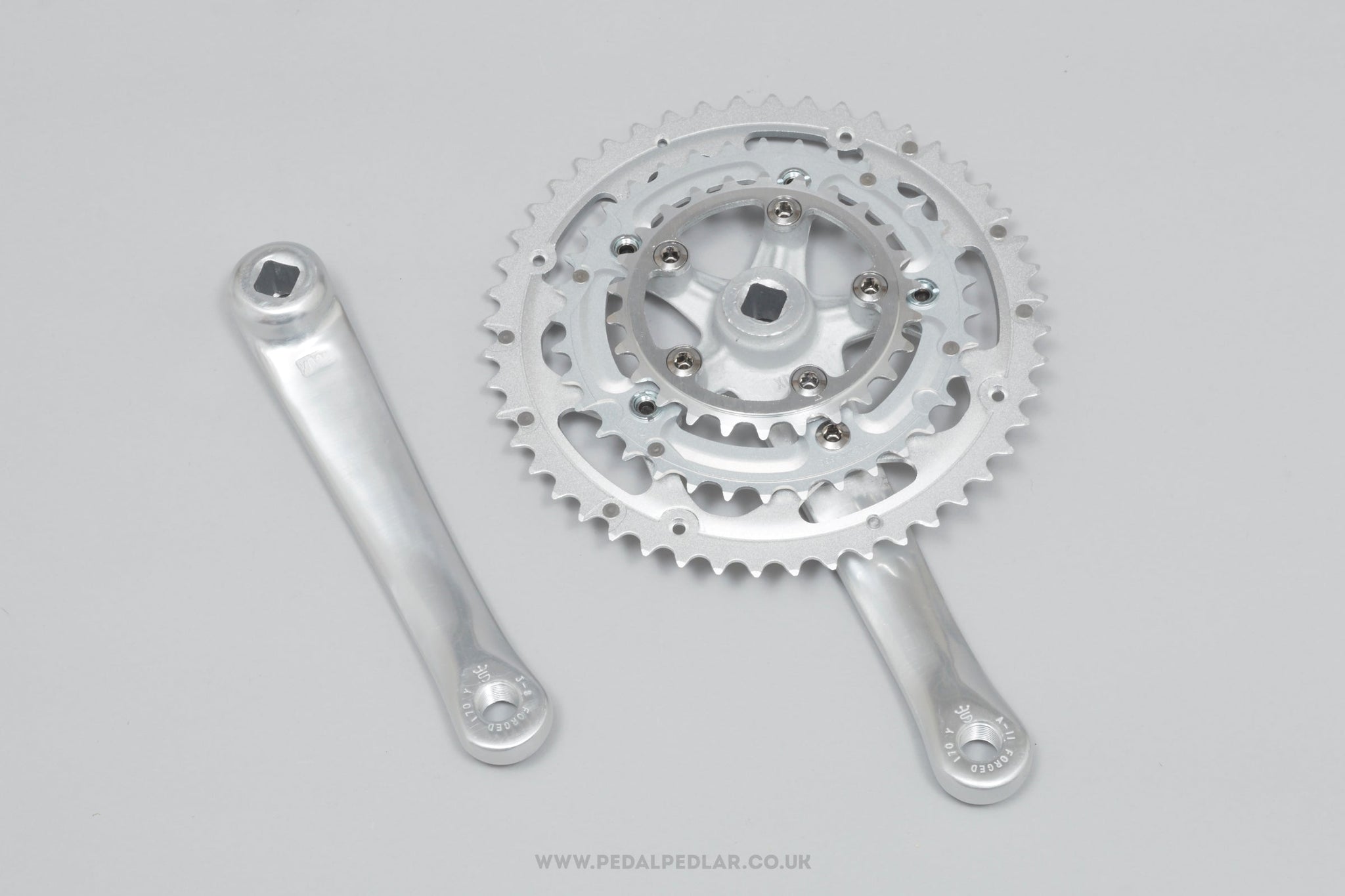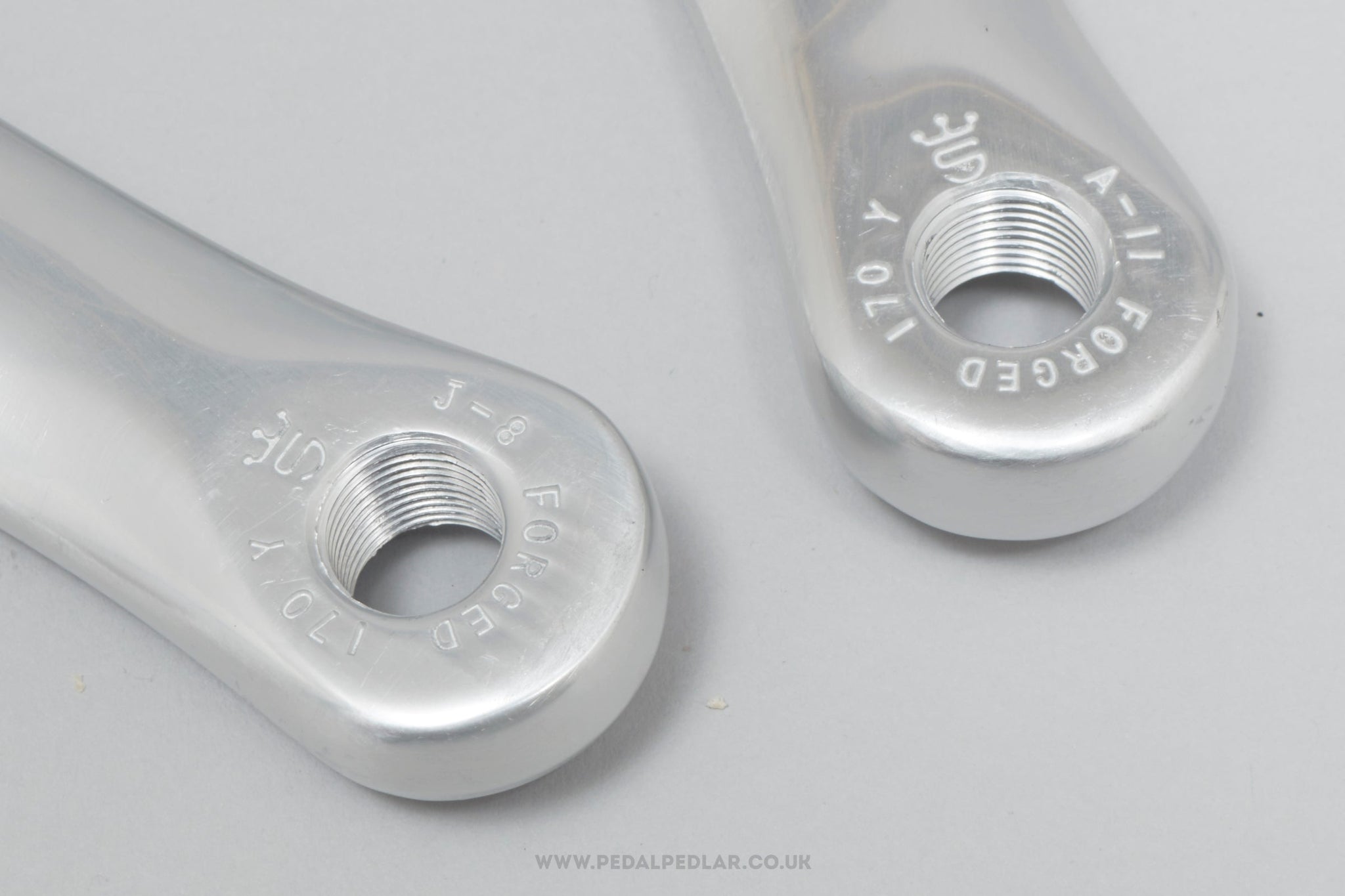- Frames
- Wheels
-
Parts
- Drivetrain & Gearing
- Downtube Shifters
- Bar Shifters
- Shift/Brake Levers
- Front Derailleurs
- Rear Derailleurs
- Chainsets
- Crank Arms
- Crank Parts
- Bottom Brackets
- Bottom Bracket Parts
- Chainrings
- Freewheels
- Cassettes
- Chains
- Gear Parts
- Braking
- Brake Sets
- Brake Calipers
- Brake Cantilevers
- Brake Levers
- Brake Parts
- Clothing
- Accessories
- Journal
8 Speed
Campagnolo C-Record / Chorus / Athena (306/051) Classic 42T 135 BCD Inner Chainring
£35.00
✓ Original part - produced in the 1990s
✓ Professionally checked & cleaned
✓ Worldwide shipping
Campagnolo C-Record / Chorus / Athena chainring, hailing from Italy and in production during the 1990s. Made from aluminium and weighing in at 50 grams. A fine choice for keeping your classic bike authentic, but also great for any other compatible bike too.
The chainring's been carefully cleaned, thoroughly checked by one of our mechanics and graded as good condition, but do take a good look at the detailed photos so you can see the cosmetic condition before you buy.OVERVIEW
Model ID - 306/051
Production Era - 1990s
Country - Italian
Material - Aluminium
Weight - 50 g
Stock Code - U-CRI33C
TECHNICAL INFO
Tooth Count - 42
Between Adjacent Bolt Holes - 79.4 mm
BCD - 135 BCD
Bolt Count - 5-Bolt
Chain Width - 3/32" (Standard)
Intended Speed* - 8 Speed, 9 Speed
-
▼SHIPPING, TAXES & RETURNS
-
We've been safely sending orders around the world since 2010. There's a handy shipping calculator on the shopping cart page so you can see the cost of postage as soon as you've added it to your basket. Your order will be carefully packed and sent with tracking & insurance, we despatch most orders within 2-3 days but larger items and orders placed before the weekend can take an extra day or two to process.
We accept returns, please notify us within 14 days and ensure the item arrives back with us no later than 30 days after the order was received.
We don't charge VAT, however, if buying from outside of the UK please remember that there may be import fees to pay directly to the delivery company before receiving the order. Unfortunately we can’t advise on the exact costs as it varies from country to country, so please check your national rates before purchasing.
-
▼HELP SECTION
-
Tooth Count - the number of teeth on the chainring, the higher the number the harder the gear.
Between Adjacent Bolt Holes - the measurement from the centre of any bolt hole to the centre of an adjacent one, if this measurement is the same as that of your crankset and the bolt count is the same then the chainring should fit.
BCD - stands for Bolt Circle Diameter (sometimes referred to as PCD - Pitch Circle Diameter) and is the technical way to determine whether the chainring fits your crankset. To calculate, multiply the distance between adjacent holes (in mm) by 1.709 (you’ll likely need to round the resulting number up or down a little).
Bolt Count - the number of bolts securing the chainring to the chainset. As with the BCD, this must be the same as your chainset.
Chain Width - 3/32” is the standard width for double and triple chainsets, wherease 1/8” chainrings are only found on single ring chainsets, generally for track / singlespeed use and can only be used with a wide 1/8" chain.
Intended Speed - the number of cogs at the back the chainring was designed to be used with. We refer to it as ‘intended’ speed as most double and triple chainsets will actually work with different speeds than originally intended, but the further away you get from the intended speed the more likely you are to experience minor setup issues. The exception being some chainrings intended for 10 speed use or higher, with these it’s better to stick to the intended speed.
Ritchey TR3 Comp NOS Classic 32h Rear Hub
£55.00
✓ Original hub - produced in the 1990s
✓ New old stock! Still unused after all these years
✓ Worldwide shipping
Ritchey TR3 Comp rear hub, hailing from the United States and in production during the 1990s (yet still new & unused after all this time!). Made from aluminium/steel and weighing in at 472 grams. A fine choice for keeping your classic bike authentic, but also great for any other compatible bike.
OVERVIEW
Bearing / Race Condition - New Old Stock*
Production Era - 1990s
Country - American
Material - Aluminium / Steel
Weight - 472 g
Stock Code - D-HU-R44C
*New old stock items may have marks from storage over the years, and as we often have multiples they can vary from piece to piece, but they are always genuine new & unused items.
TECHNICAL INFO
Spoke Drilling - 32 Hole
Spacing (O.L.D.) - 135 mm
Speed - 8 Speed, 9 Speed, 10 Speed
Sprocket Fitting - Shimano Hyperglide
-
▼SHIPPING, TAXES & RETURNS
-
We've been safely sending orders around the world since 2010. There's a handy shipping calculator on the shopping cart page so you can see the cost of postage as soon as you've added it to your basket. Your order will be carefully packed and sent with tracking & insurance, we despatch most orders within 2-3 days but larger items and orders placed before the weekend can take an extra day or two to process.
We accept returns, please notify us within 14 days and ensure the item arrives back with us no later than 30 days after the order was received.
We don't charge VAT, however, if buying from outside of the UK please remember that there may be import fees to pay directly to the delivery company before receiving the order. Unfortunately we can’t advise on the exact costs as it varies from country to country, so please check your national rates before purchasing.
-
▼HELP SECTION
-
Spoke Drilling - the number of holes for the spokes, your wheel rim needs to match the hub exactly.
Spacing (O.L.D.) - the width of the hub measured at its widest point, from the outside of the locking end nuts (O.L.D. = Over Locknut Dimension), not including the hub axle. This measurement needs to match the inside of your frame's dropouts. Steel frames can be stretched or squeezed a few mm but it's always best to avoid this if possible, aluminium or carbon frames should never be stretched.
Speed - the number of cogs the hub was designed to be used with.
Sprocket Fitting - for cassette hubs this refers to the spline pattern (the shape of the cogs where they slide on to the hub) and this must match the cassette you intend to use. With freewheel hubs it refers to the thread, ISO is the modern standard and is almost exactly the same as older English/British and Italian thread, allowing you to mix and match between these thread types as long as it's not going to be under extreme force, in which case it's best to stick to an exact match. Freewheel hubs with a French thread must be used with a French threaded freewheel.
Sport Energy Large Flange Classic 18h Rear Hub
£65.00
✓ Original hub - in production from the 1990s to the 2000s
✓ Professionally checked, cleaned & serviced
✓ Worldwide shipping
Sport Energy rear hub, in production from the 1990s to the 2000s. Made from aluminium/steel and weighing in at 366 grams. A fine choice for keeping your classic bike authentic, but also great for any other compatible bike too.
The hub's been carefully cleaned, thoroughly serviced by one of our mechanics and graded as very good condition, but do take a good look at the detailed photos so you can see the cosmetic condition before you buy.OVERVIEW
Bearing / Race Condition - New
Condition Notes - New sealed bearing units installed.
Production Era - 1990s & 2000s
Country - 0
Material - Aluminium / Steel
Weight - 366 g
Stock Code - U-HU-R25C
TECHNICAL INFO
Spoke Drilling - 18 Hole
Spacing (O.L.D.) - 130 mm
Speed - 8 Speed, 9 Speed, 10 Speed
Sprocket Fitting - Shimano Hyperglide
-
▼SHIPPING, TAXES & RETURNS
-
We've been safely sending orders around the world since 2010. There's a handy shipping calculator on the shopping cart page so you can see the cost of postage as soon as you've added it to your basket. Your order will be carefully packed and sent with tracking & insurance, we despatch most orders within 2-3 days but larger items and orders placed before the weekend can take an extra day or two to process.
We accept returns, please notify us within 14 days and ensure the item arrives back with us no later than 30 days after the order was received.
We don't charge VAT, however, if buying from outside of the UK please remember that there may be import fees to pay directly to the delivery company before receiving the order. Unfortunately we can’t advise on the exact costs as it varies from country to country, so please check your national rates before purchasing.
-
▼HELP SECTION
-
Spoke Drilling - the number of holes for the spokes, your wheel rim needs to match the hub exactly.
Spacing (O.L.D.) - the width of the hub measured at its widest point, from the outside of the locking end nuts (O.L.D. = Over Locknut Dimension), not including the hub axle. This measurement needs to match the inside of your frame's dropouts. Steel frames can be stretched or squeezed a few mm but it's always best to avoid this if possible, aluminium or carbon frames should never be stretched.
Speed - the number of cogs the hub was designed to be used with.
Sprocket Fitting - for cassette hubs this refers to the spline pattern (the shape of the cogs where they slide on to the hub) and this must match the cassette you intend to use. With freewheel hubs it refers to the thread, ISO is the modern standard and is almost exactly the same as older English/British and Italian thread, allowing you to mix and match between these thread types as long as it's not going to be under extreme force, in which case it's best to stick to an exact match. Freewheel hubs with a French thread must be used with a French threaded freewheel.
Sugino XD2 (XD 500D) NOS/NIB Classic 170 mm Road/Touring Chainset
£145.00
✓ Original part - in production from the 1990s to the 2000s
✓ New old stock & still in the original packaging!
✓ Lightweight for the era - just 699 grams
✓ Worldwide shipping
Sugino XD2 crank/chainset, hailing from Japan and in production from the 1990s to the 2000s (yet still new & unused after all this time!). Made from aluminium and weighing in at 699 grams - pretty lightweight for a chainset at that time. A fine choice for keeping your classic bike authentic, but also great for any other compatible bike too.
OVERVIEW
Chainring Condition - New Old Stock*
Model ID - XD 500D
Production Era - 1990s & 2000s
Country - Japanese
Material - Aluminium
Weight - 699 g
Stock Code - D-CS105C
*New old stock items may have marks from storage over the years, and as we often have multiples they can vary from piece to piece, but they are always genuine new & unused items.
TECHNICAL INFO
Chainring Count - Double
Tooth Count - 48 / 36
Bottom Bracket Type - Square Taper
BCD - 110 BCD
Chain Width - 3/32" (Standard)
Crank Arm Length - 170 mm
Pedal Threads - Standard (9/16" x 20 TPI)
Intended Speed* - 8 Speed, 9 Speed
Bike Type* - Road/Touring
*See help section.
-
▼SHIPPING, TAXES & RETURNS
-
We've been safely sending orders around the world since 2010. There's a handy shipping calculator on the shopping cart page so you can see the cost of postage as soon as you've added it to your basket. Your order will be carefully packed and sent with tracking & insurance, we despatch most orders within 2-3 days but larger items and orders placed before the weekend can take an extra day or two to process.
We accept returns, please notify us within 14 days and ensure the item arrives back with us no later than 30 days after the order was received.
We don't charge VAT, however, if buying from outside of the UK please remember that there may be import fees to pay directly to the delivery company before receiving the order. Unfortunately we can’t advise on the exact costs as it varies from country to country, so please check your national rates before purchasing.
-
▼HELP SECTION
-
Chainring Count - the number of chainrings on the chainset. Fixed gear track bikes, single-speeds and some geared bikes use a single chainring, road bikes commonly use a double (two rings) and most touring bikes and mountain bikes will use a triple chainset (three rings).
Tooth count - the number of teeth on the chainring(s), the higher the number the harder the gear.
Chain width - this is only relevant for chainsets with a single chainring - if this is ⅛” then you must use a ⅛” chain. All double and triple (and some single) ring chainsets will use a standard 3/32” chain.
BCD - stands for Bolt Circle Diameter (sometimes referred to as PCD - Pitch Circle Diameter) and is only really needed when changing chainrings. To calculate the BCD, measure the distance in millimeters from the centre of any chainring bolt to the centre of an adjacent one and multiply it by 1.709 (you’ll likely need to round the resulting number up or down a little to get your BCD measurement).
*Intended speed - the number of cogs at the back the chainset was designed to be used with. We refer to it as ‘intended’ speed as most double and triple chainsets will actually work with different speeds than originally intended, but the further away you get from the intended speed the more likely you are to experience minor setup issues. The exception being some chainsets intended for 10 speed use or higher, with these it’s better to stick to the intended speed.
Crank arm length - this is measured from the absolute centre of the bottom bracket hole to the centre of the hole for the pedal.
Pedal threads - the thread type to match that of the chainset, this must match and is usually stamped on the pedals themselves and most bikes use a standard thread of 9/16” x 20 tpi. The exceptions being older French bikes, bikes with cheaper one-piece type chainsets and Shimano’s Dyna Drive system (easily identifiable as the pedal holes are about an inch wide!).
Bottom bracket type - ‘square taper’, as the name suggests have a square shaped axle that slots into the chainset and ‘cottered’ axles are round and secured by pins - pretty much every bike up until the 1990s would use one of these, cottered being the much earlier system. Since then, different manufacturers have introduced their own systems that are not interchangeable so you must use a chainset that matches.
Sugino XD2 (XD 600T) NOS/NIB Classic Triple 170 mm Touring Chainset
£195.00
✓ Original part - in production from the 1990s to the 2000s
✓ New old stock & still in the original packaging!
✓ Worldwide shipping
Sugino XD2 crank/chainset, hailing from Japan and in production from the 1990s to the 2000s (yet still new & unused after all this time!). Made from aluminium and weighing in at 755 grams. A fine choice for keeping your classic bike authentic, but also great for any other compatible bike too.
OVERVIEW
Chainring Condition - New Old Stock*
Model ID - XD 600T
Production Era - 1990s & 2000s
Country - Japanese
Material - Aluminium
Weight - 755 g
Stock Code - D-CS104C
*New old stock items may have marks from storage over the years, and as we often have multiples they can vary from piece to piece, but they are always genuine new & unused items.
TECHNICAL INFO
Chainring Count - Triple
Tooth Count - 48 / 36 / 26
Bottom Bracket Type - Square Taper
BCD - 110 / 74 BCD
Chain Width - 3/32" (Standard)
Crank Arm Length - 170 mm
Pedal Threads - Standard (9/16" x 20 TPI)
Intended Speed* - 8 Speed, 9 Speed
Bike Type* - Touring
*See help section.
-
▼SHIPPING, TAXES & RETURNS
-
We've been safely sending orders around the world since 2010. There's a handy shipping calculator on the shopping cart page so you can see the cost of postage as soon as you've added it to your basket. Your order will be carefully packed and sent with tracking & insurance, we despatch most orders within 2-3 days but larger items and orders placed before the weekend can take an extra day or two to process.
We accept returns, please notify us within 14 days and ensure the item arrives back with us no later than 30 days after the order was received.
We don't charge VAT, however, if buying from outside of the UK please remember that there may be import fees to pay directly to the delivery company before receiving the order. Unfortunately we can’t advise on the exact costs as it varies from country to country, so please check your national rates before purchasing.
-
▼HELP SECTION
-
Chainring Count - the number of chainrings on the chainset. Fixed gear track bikes, single-speeds and some geared bikes use a single chainring, road bikes commonly use a double (two rings) and most touring bikes and mountain bikes will use a triple chainset (three rings).
Tooth count - the number of teeth on the chainring(s), the higher the number the harder the gear.
Chain width - this is only relevant for chainsets with a single chainring - if this is ⅛” then you must use a ⅛” chain. All double and triple (and some single) ring chainsets will use a standard 3/32” chain.
BCD - stands for Bolt Circle Diameter (sometimes referred to as PCD - Pitch Circle Diameter) and is only really needed when changing chainrings. To calculate the BCD, measure the distance in millimeters from the centre of any chainring bolt to the centre of an adjacent one and multiply it by 1.709 (you’ll likely need to round the resulting number up or down a little to get your BCD measurement).
*Intended speed - the number of cogs at the back the chainset was designed to be used with. We refer to it as ‘intended’ speed as most double and triple chainsets will actually work with different speeds than originally intended, but the further away you get from the intended speed the more likely you are to experience minor setup issues. The exception being some chainsets intended for 10 speed use or higher, with these it’s better to stick to the intended speed.
Crank arm length - this is measured from the absolute centre of the bottom bracket hole to the centre of the hole for the pedal.
Pedal threads - the thread type to match that of the chainset, this must match and is usually stamped on the pedals themselves and most bikes use a standard thread of 9/16” x 20 tpi. The exceptions being older French bikes, bikes with cheaper one-piece type chainsets and Shimano’s Dyna Drive system (easily identifiable as the pedal holes are about an inch wide!).
Bottom bracket type - ‘square taper’, as the name suggests have a square shaped axle that slots into the chainset and ‘cottered’ axles are round and secured by pins - pretty much every bike up until the 1990s would use one of these, cottered being the much earlier system. Since then, different manufacturers have introduced their own systems that are not interchangeable so you must use a chainset that matches.
SUBSCRIBE TO GET THE FIRST SCOOP
Exclusive content, new products, subscriber only promotions. Delivered to your inbox by tiny cyclists, every few weeks.
Don't worry, you can unsubscribe at any time.
PEDAL PEDLAR
T: 02036758003 // E: info@pedalpedlar.co.uk
© 2025 Pedal Pedlar.
Ecommerce Software by Shopify


